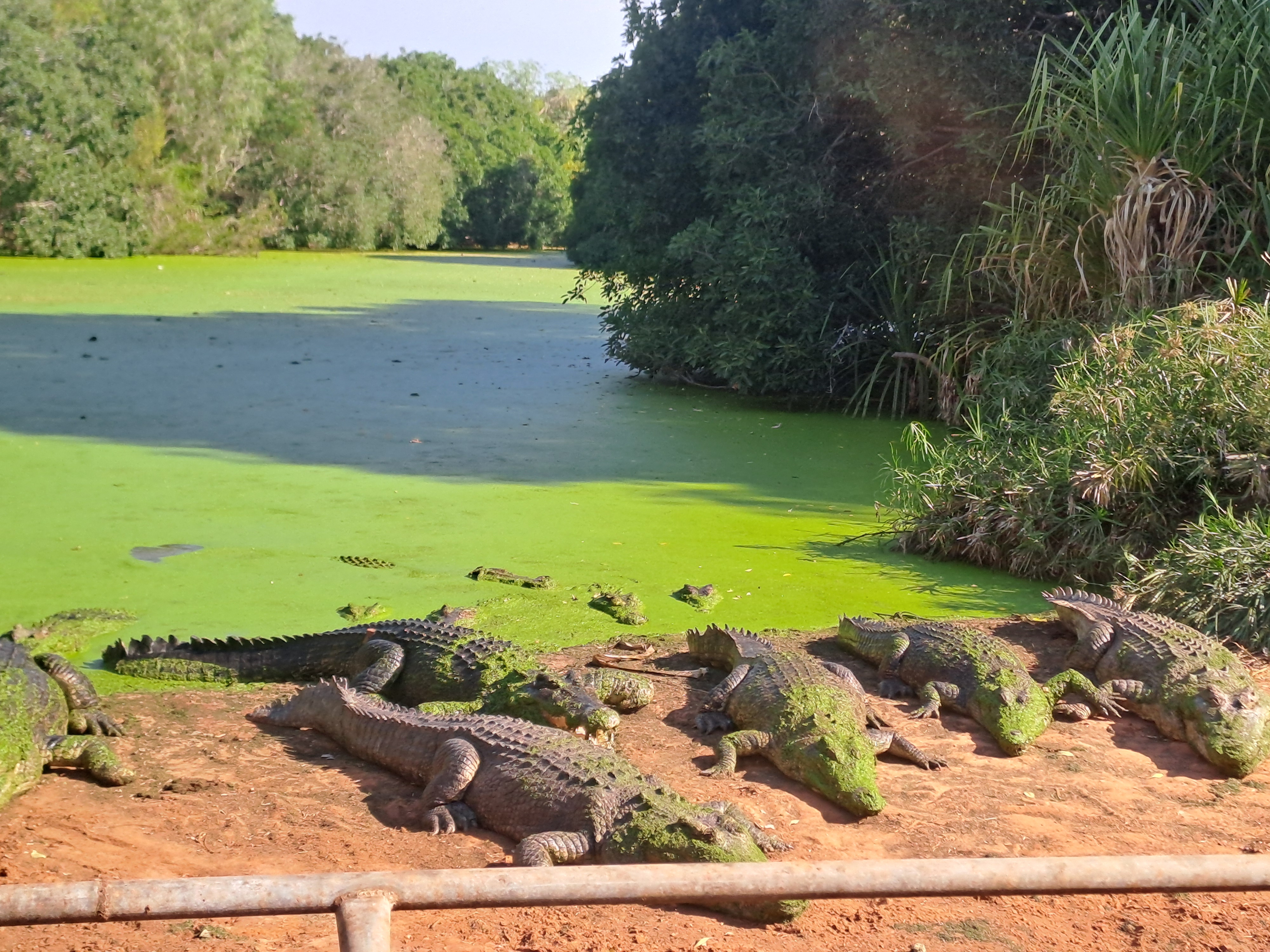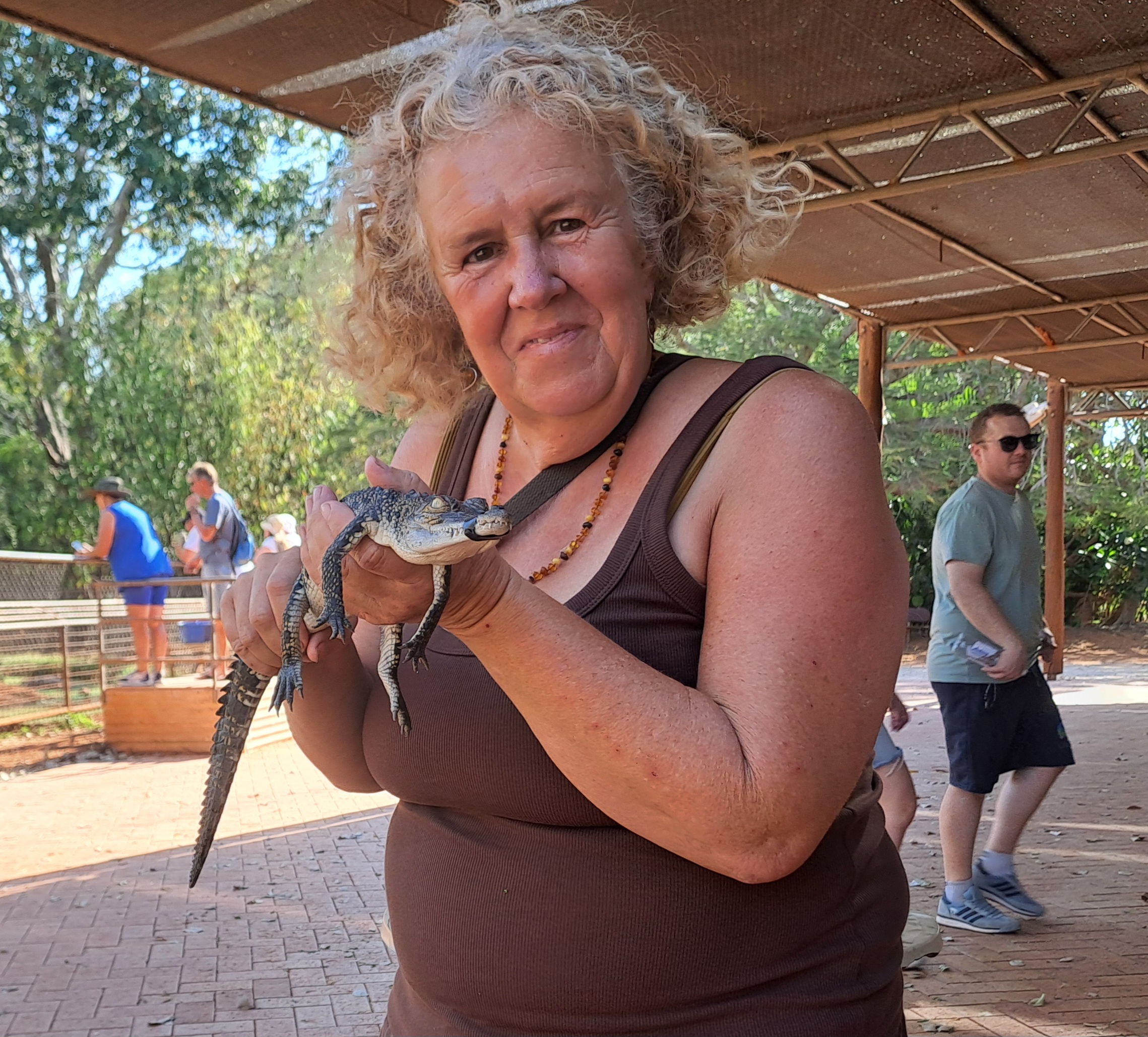15th to 26th September 2025
Onto our second State following journey through Northern Territory (Ashley being pedantic about states and territorys in Australia) we’re beginning to feel that we’ve got the routine. All shopping has to be planned carefully, how many days to the next town? How much room in the fridge for fresh food? Have we got plenty of canned and dried food? UHT milk? Bread in the freezer?
We have to plan out all the petrol stops in advance, if we miss one we are sunk, it can be 250km between petrol stations. Bottle shops are even fewer than supermarkets and only open limited hours and for limited amounts, so we need to keep that stockpiled as well. For some reason they don’t do boxes of wine, as it’s too much. Haven’t they come across 1.5 or 2 litre boxes? So bottles of wine get decanted into plastic water bottles for safety on the road for Janet (Ashley drinks cans of beer).
As we rolled into Western Australia we had also had to plan for running out of fresh fruit and veg in advance as here we had to go through a customs check to make sure we were all clear. No fresh fruit or veg allowed across the border.
A check inside our fridge, by the customs officer, lovely clean salad trays, I was proud of them and inside our cupboards and then we were through.
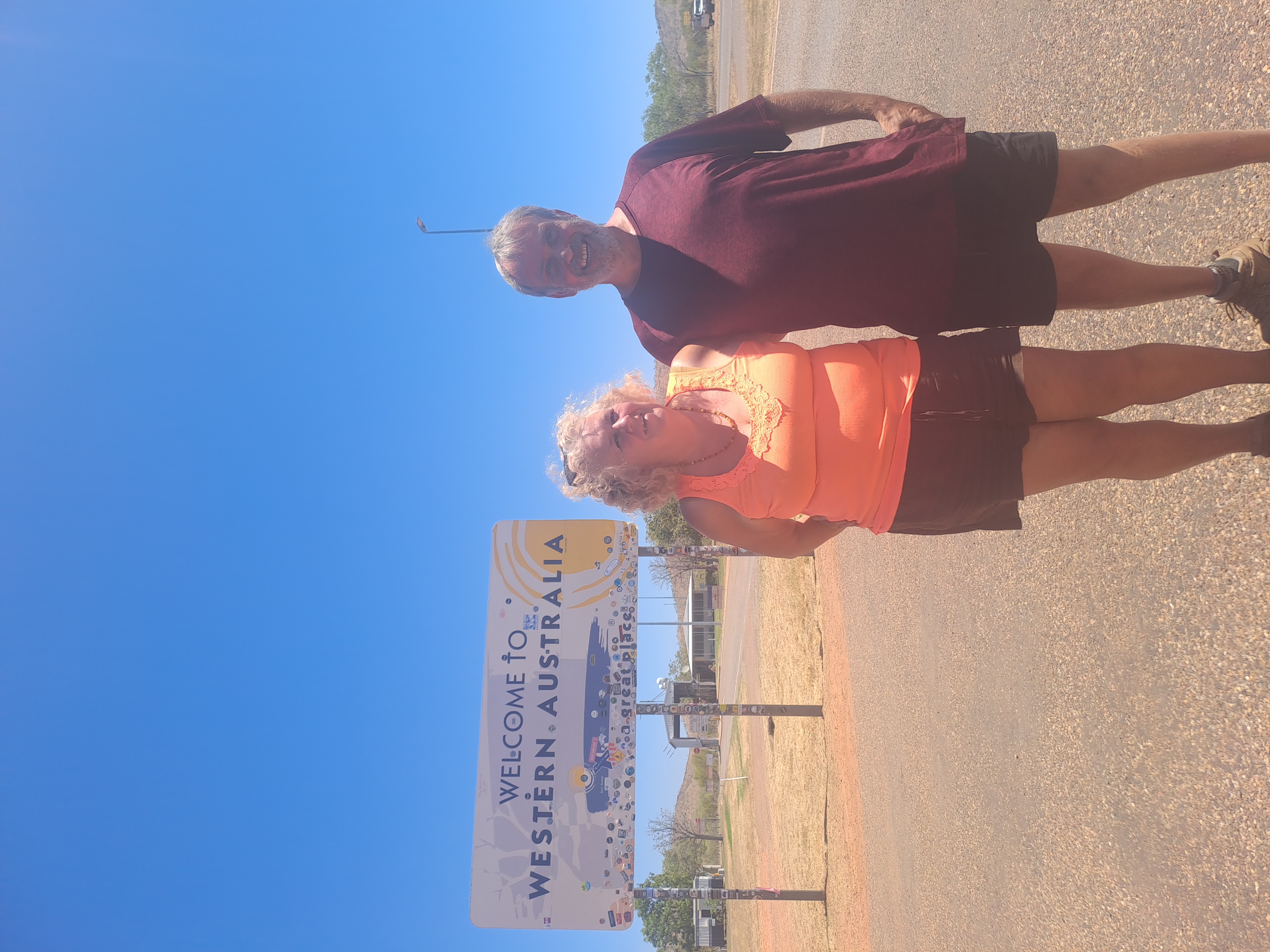

First stop the supermarket at Kununurra to restock, followed by the bottle shop as it had been a long time since Mount Isa. There we were met with warnings that information was shared on the central data base so you couldn’t top up with your daily allowance at several shops as they were all linked. We also needed our passports for any purchases.
Then on to our campsite in town. It had been a difficult decision, out by lake Argyle or in town but I took advice from Sue on our Madventure tour and I was glad to be in town.
Just out from town was the Mirima National Park or as locals would have it the mini Bungle Bungles.
As advised, we got there early in the day before it got too hot and had a lovely peaceful morning there. We even stayed for lunch as it was easily accessible in the campervan.
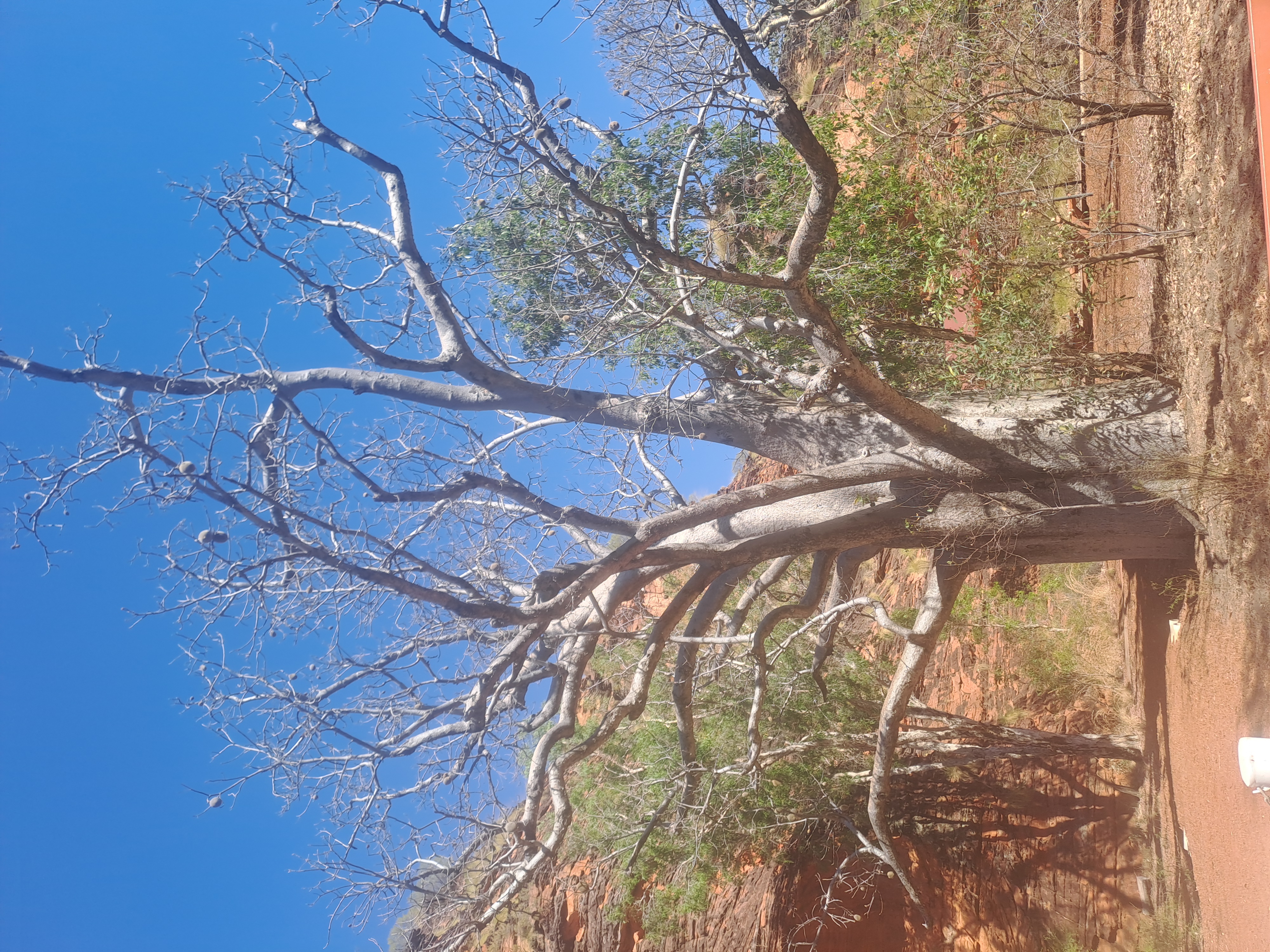



Some of the walks were designed for wheelchairs, some more rugged, but all were fairly short. There were benches and tables and shade. We varied between absolute peace with no one, a good chat and lunch with another couple and a school party invasion.
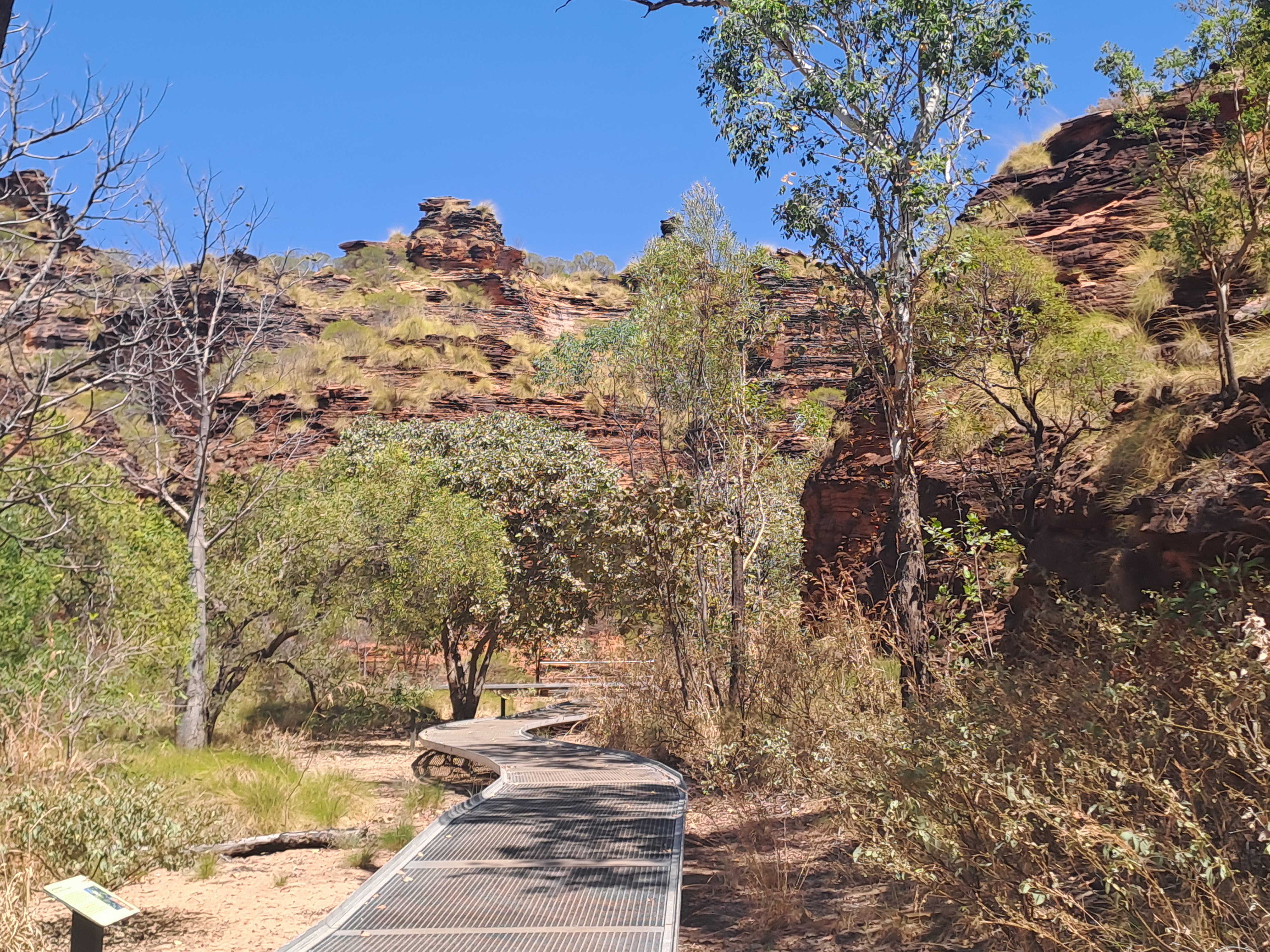

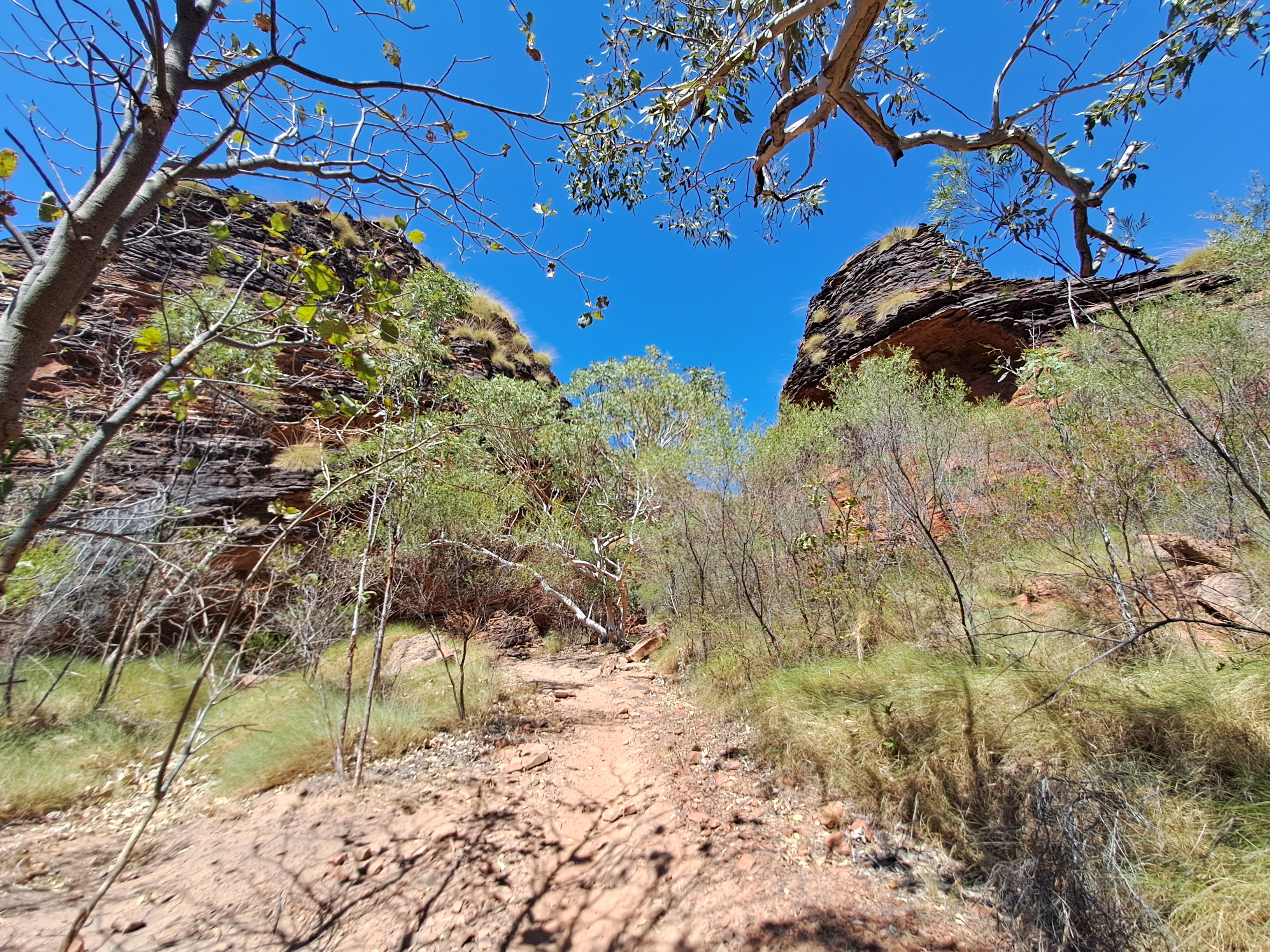
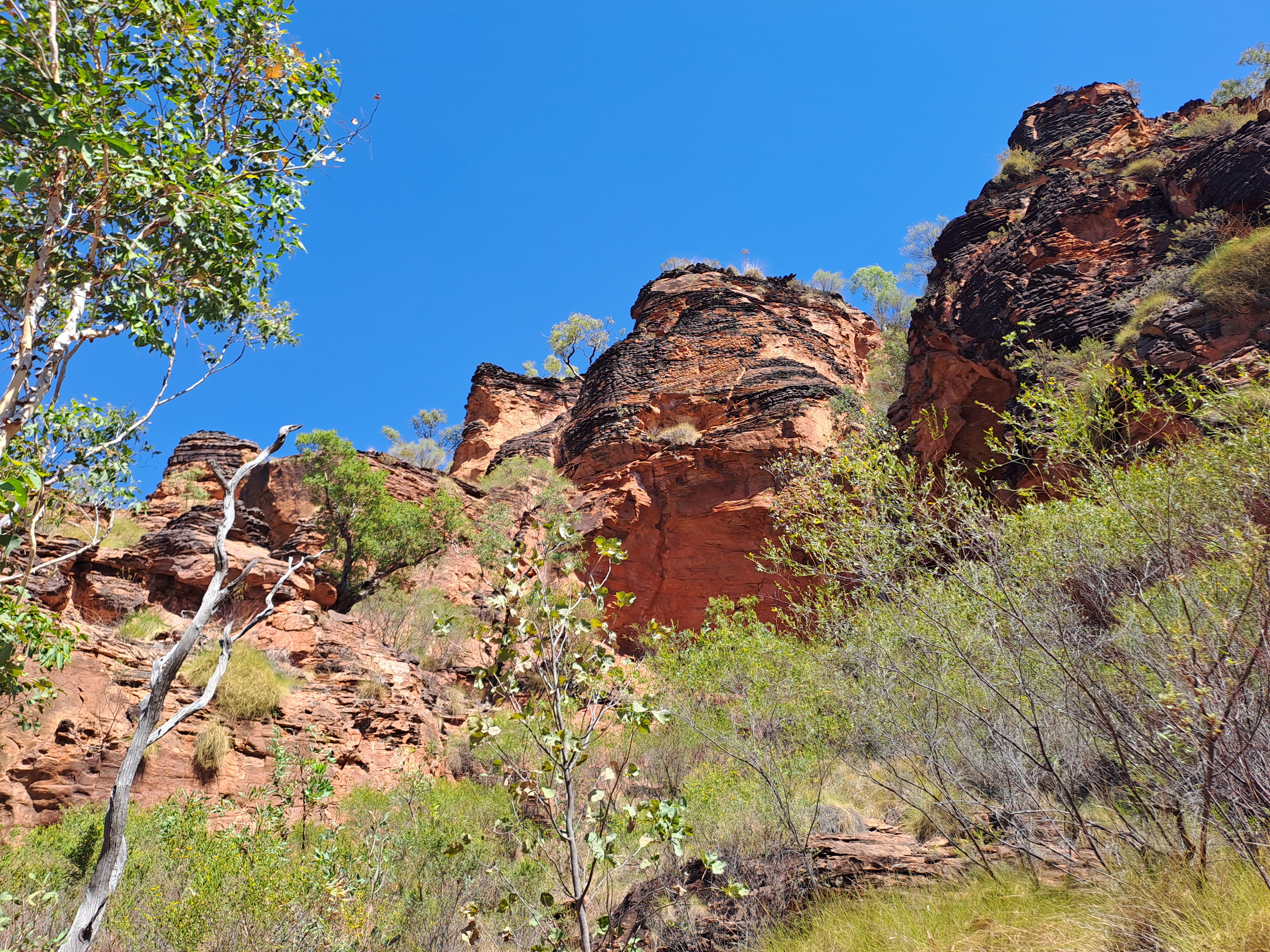
Next morning we were up at 5am for a flight over the Bungle Bungles. Our timings from Cairns to here had actually been to get us to the Bungle Bungles caravan park and a 4 wheel drive tour from there. However, a week previously we’d had an email to tell us that both their vehicles were off the road with no parts due till October. So that was the end of tours for the season.
The cheapest alternative was a aeroplane tour, so this was it. We travelled over Lake Argyle, a man made lake covering a vast area. A dam was built during 1979 to 81 to make the lake and store water, the dam is an earth construction, not concrete. This gives it greater capacity to ride earthquakes as indeed it has. This is necessary as there is a fault line between the lake and the Bungle Bungles. Hydro electricity was added paid for by Rio Tinto Mining as they needed power.
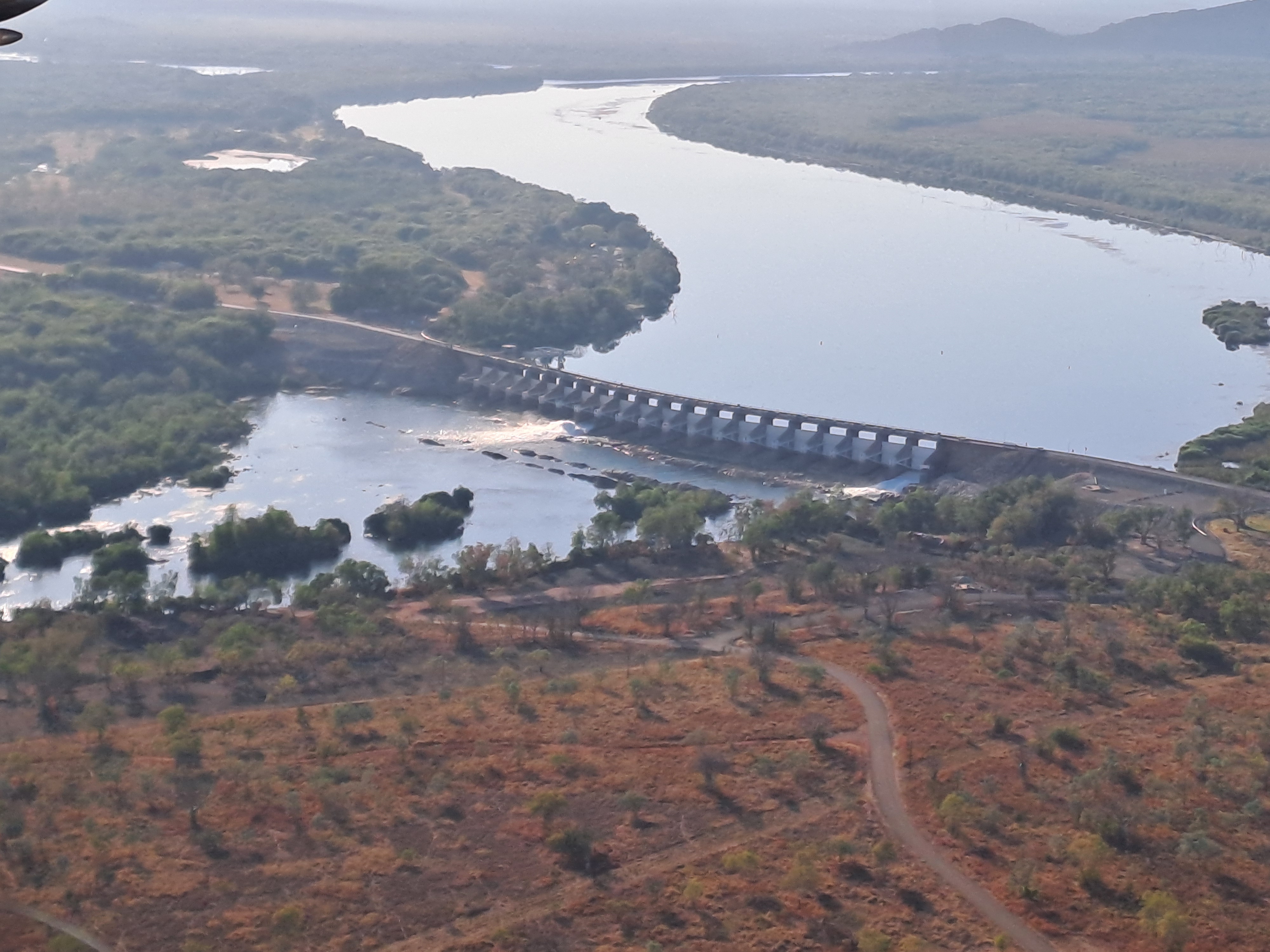
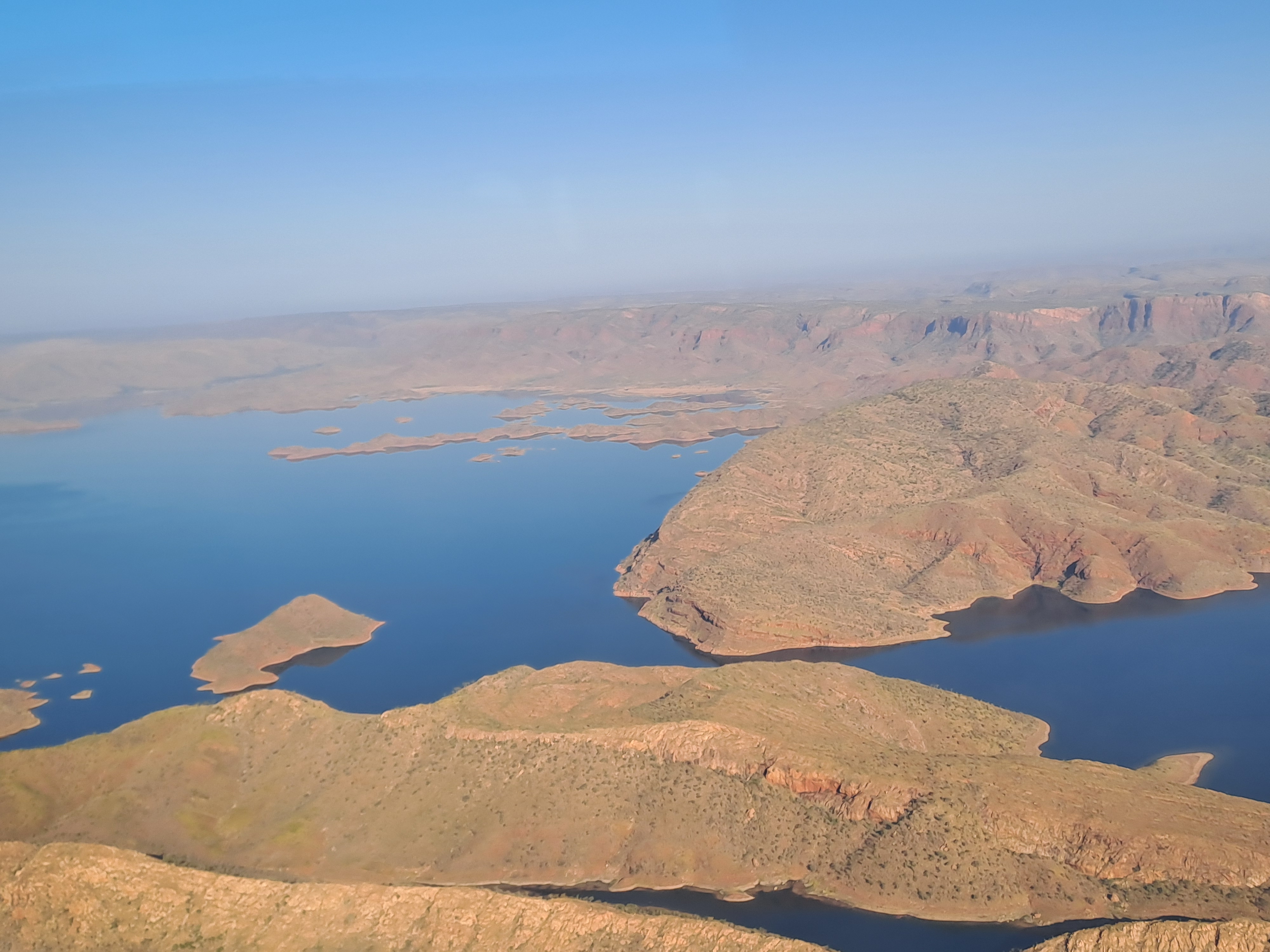
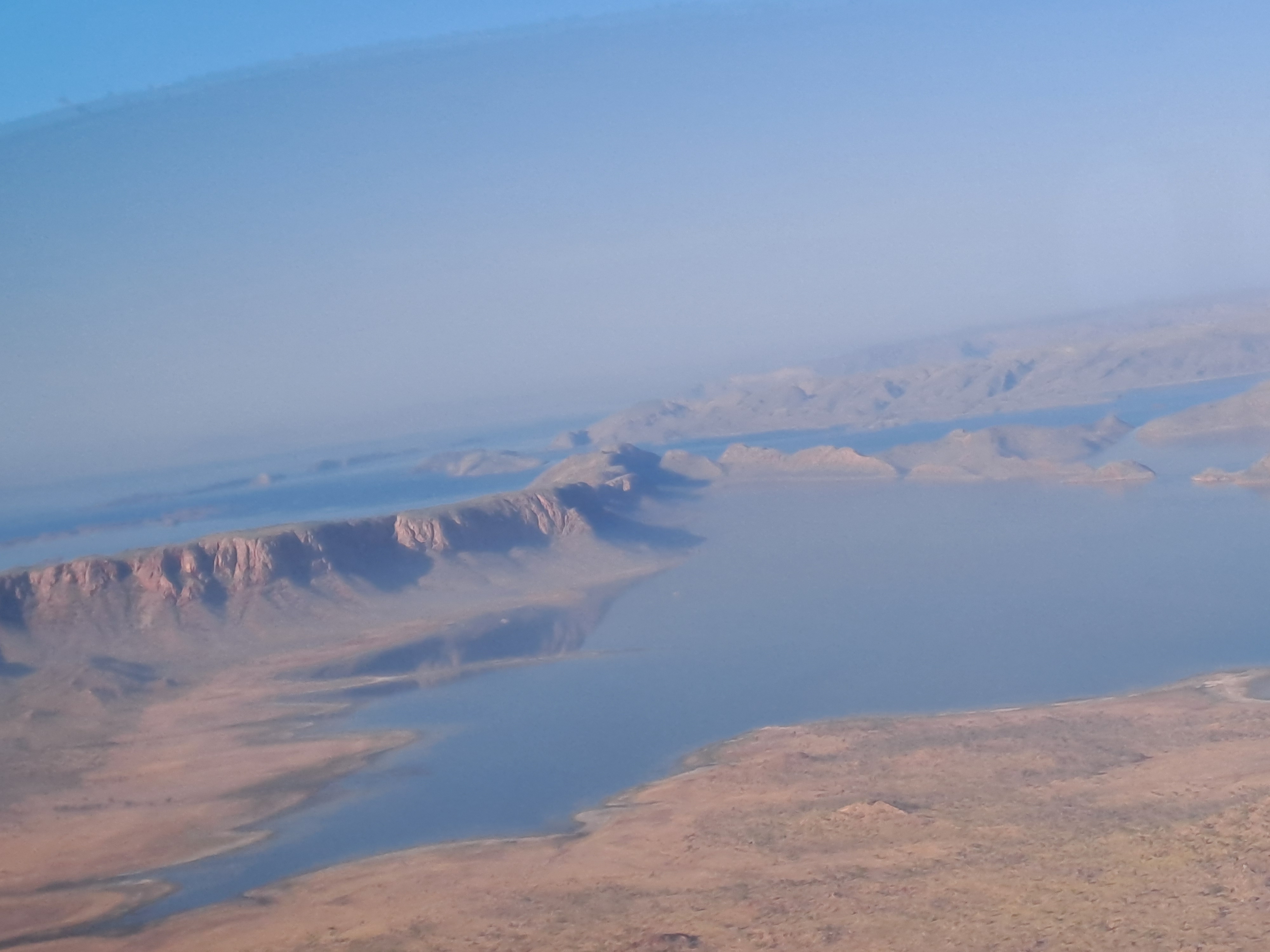
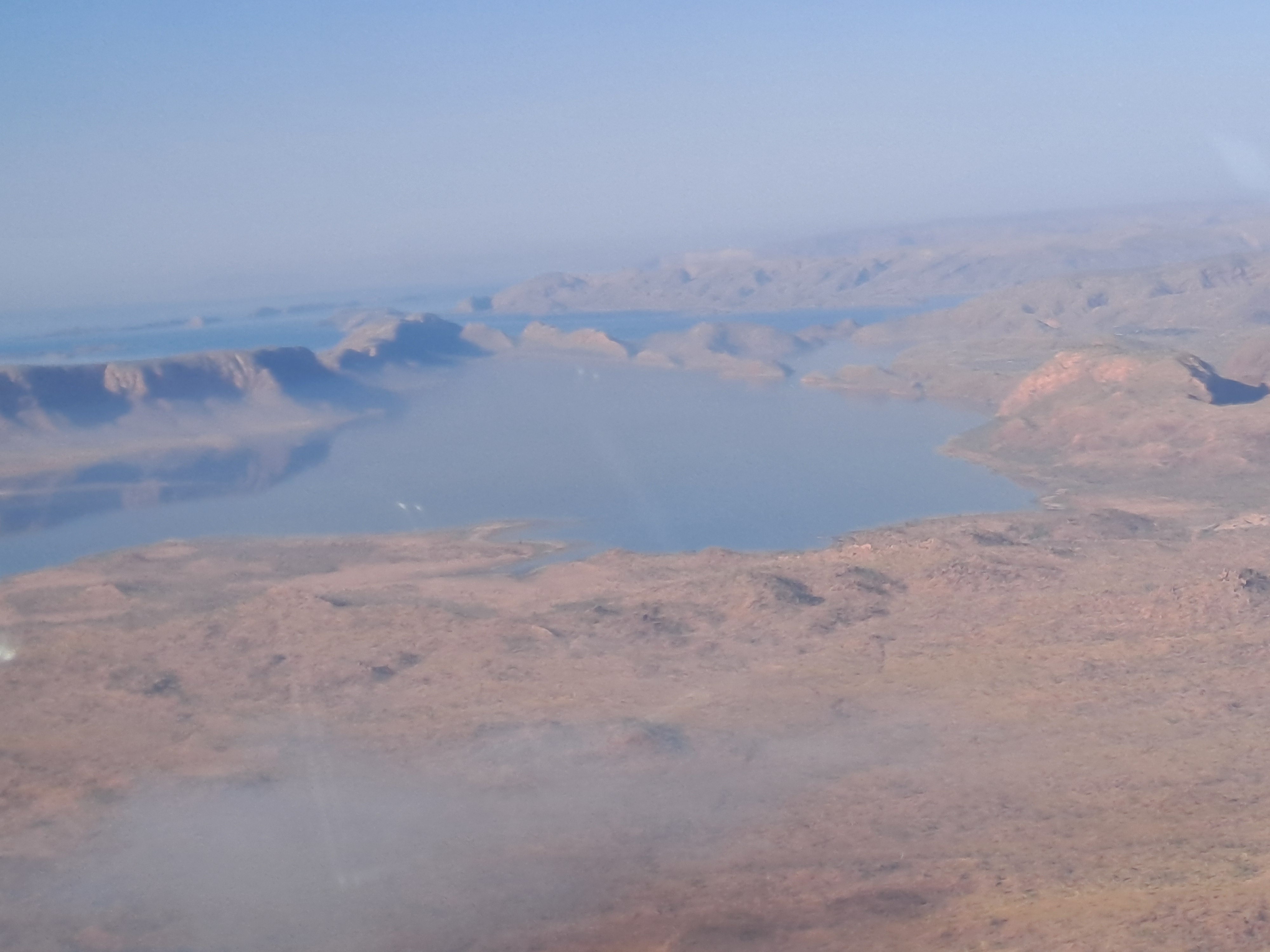
The Bungle Bungles really aren’t done justice by my photos. They are made up of layers of sandstone some with iron in causing the orange colour, some that absorb more water causing black algae growth. Years of erosion has caused the shapes.
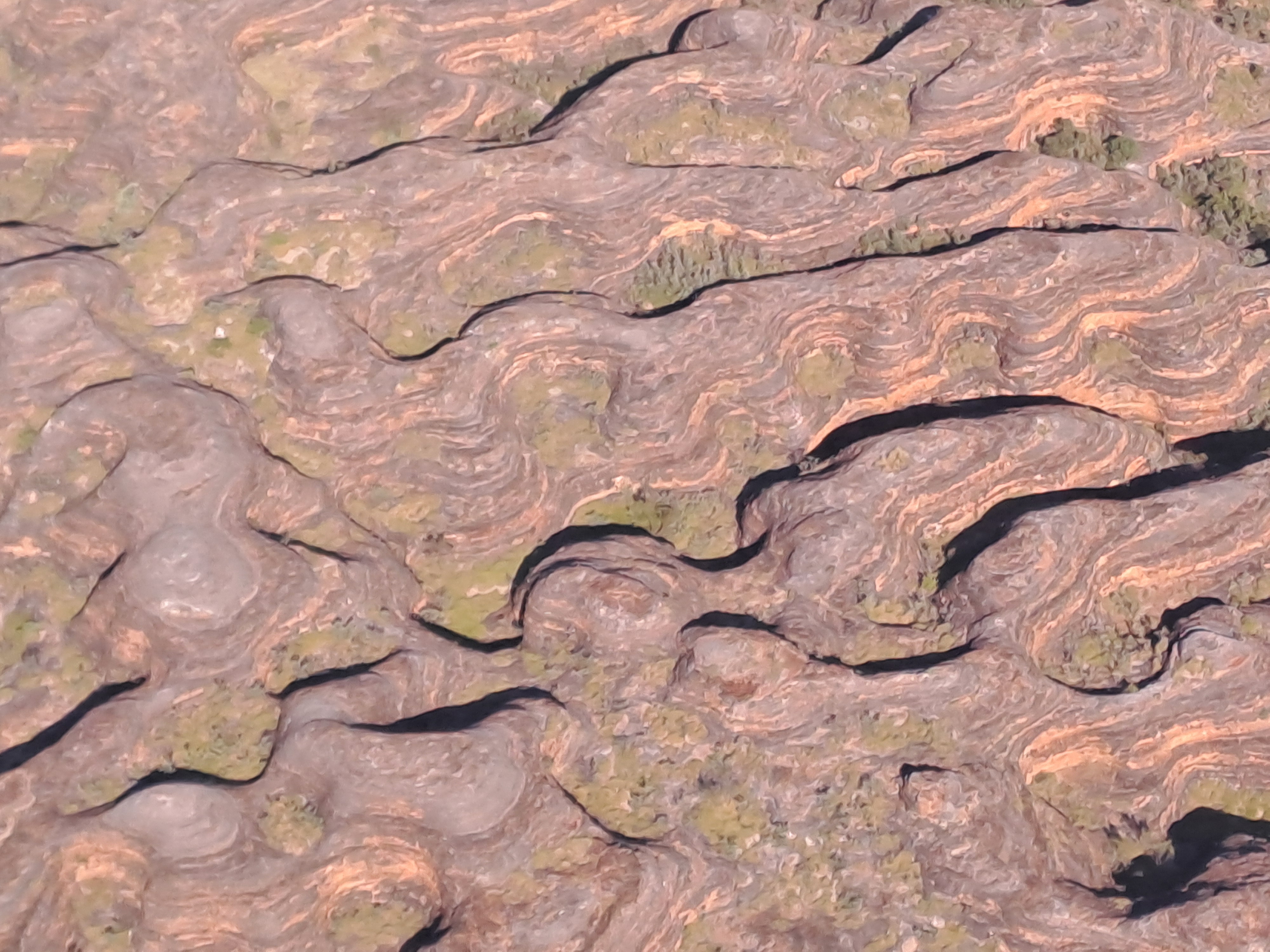
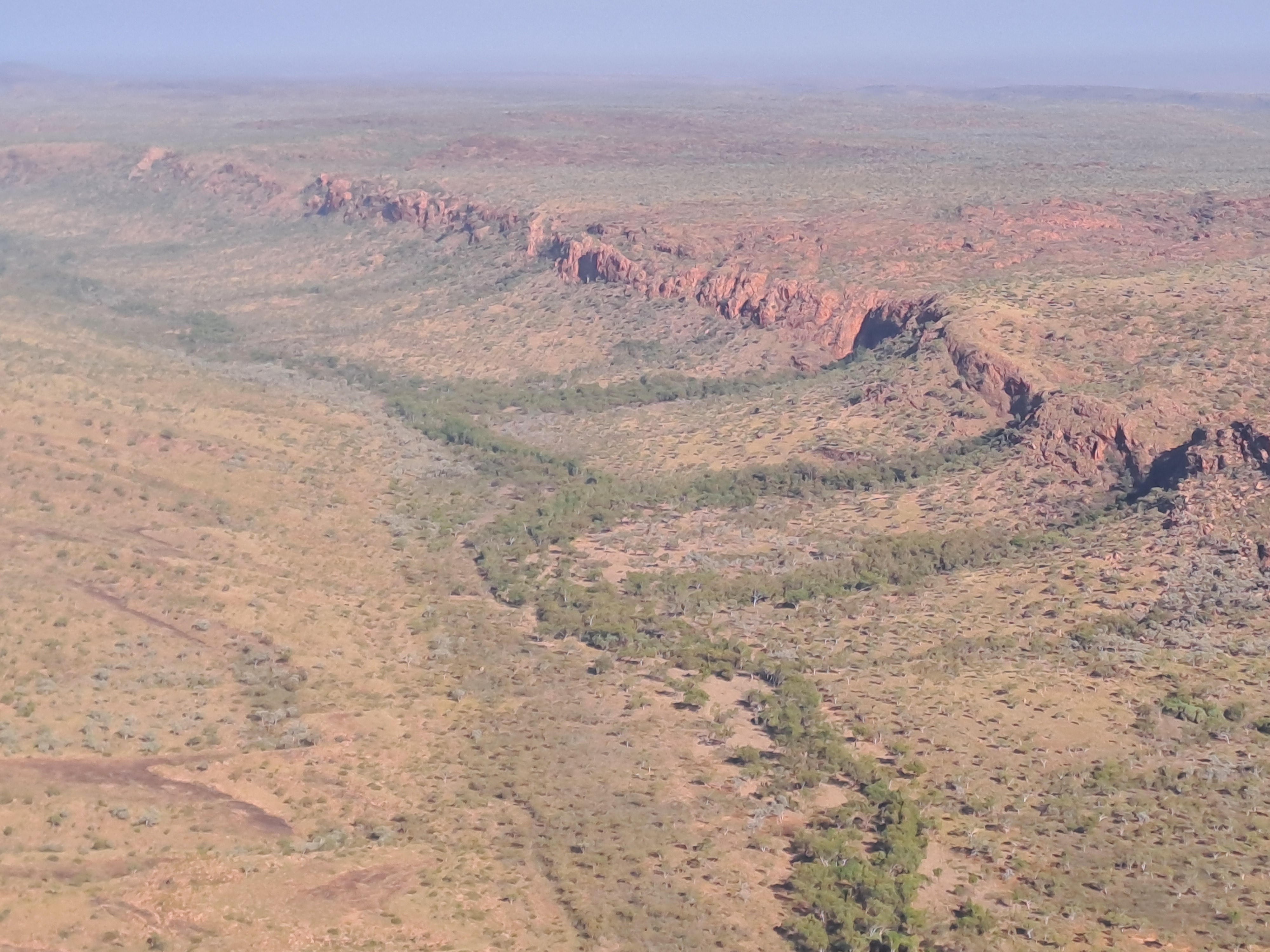
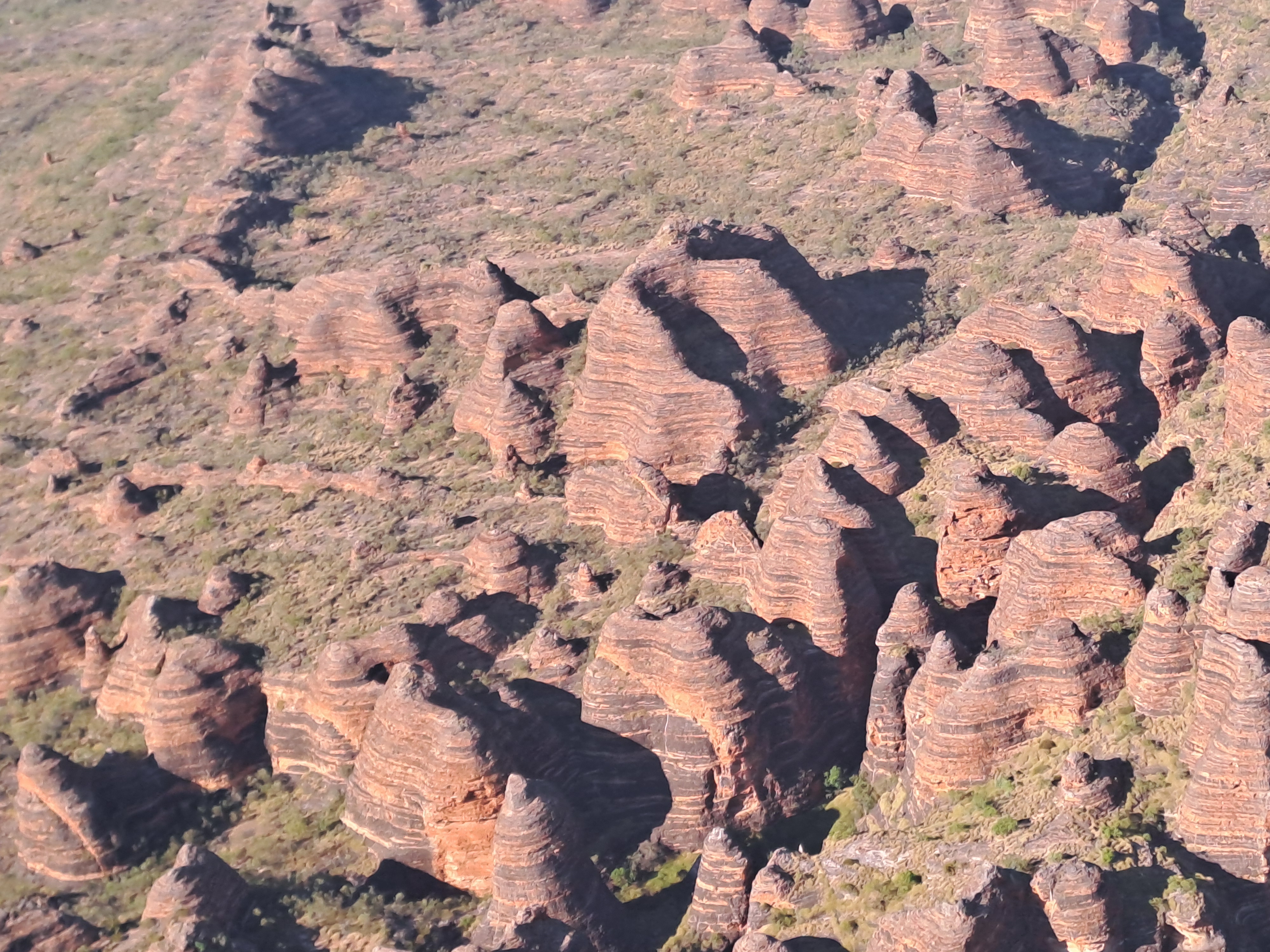
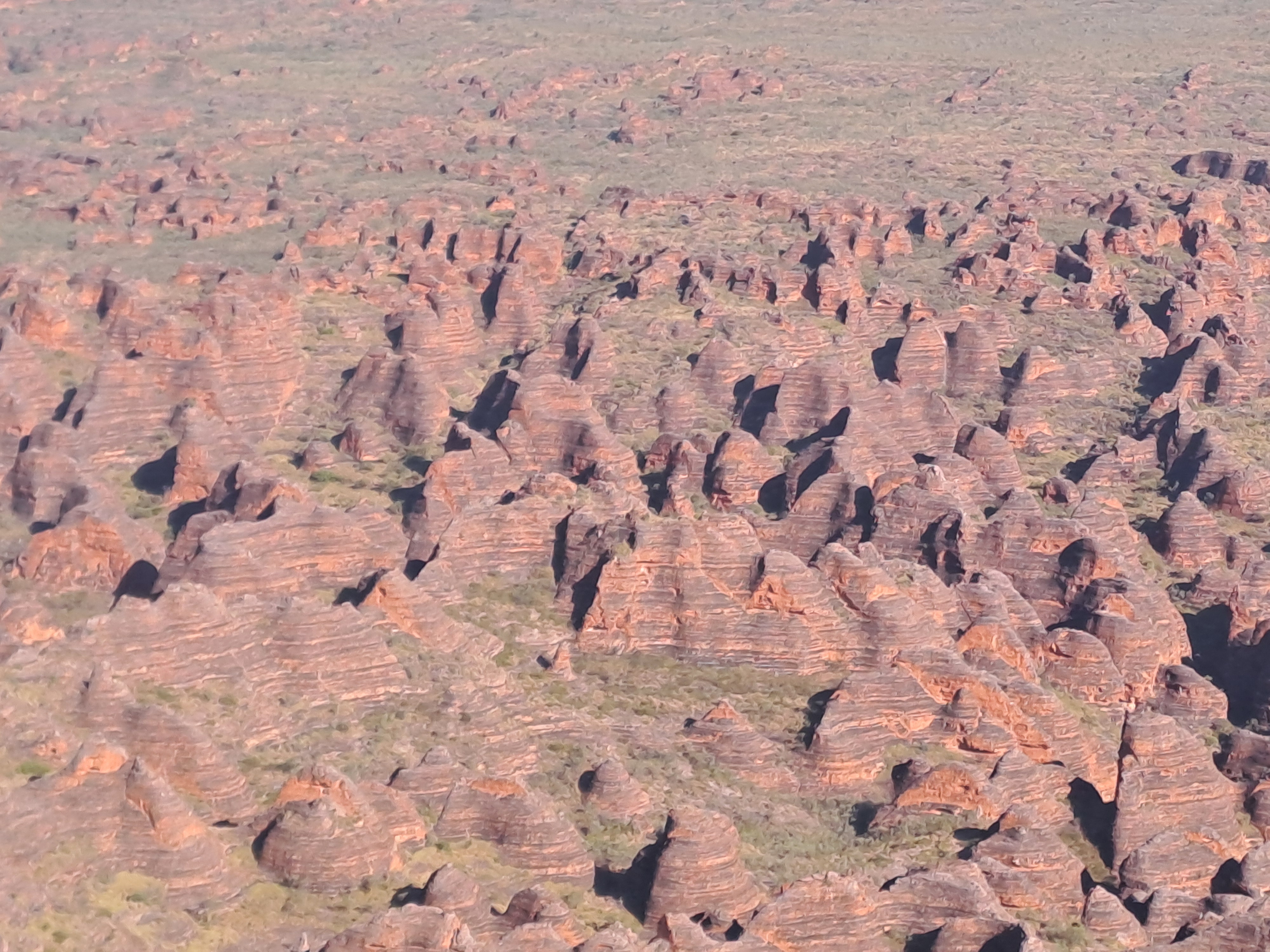
We also saw the fault line, or its effects and then came to the now closed diamond mine currently undergoing landscape restoration work. See the pictures with all the steps in. This was once the most productive mine in the world and produced most of the world’s pink diamonds, about a champagne glass full a year. It has now reached the level where mining is no longer productive so it has been closed.
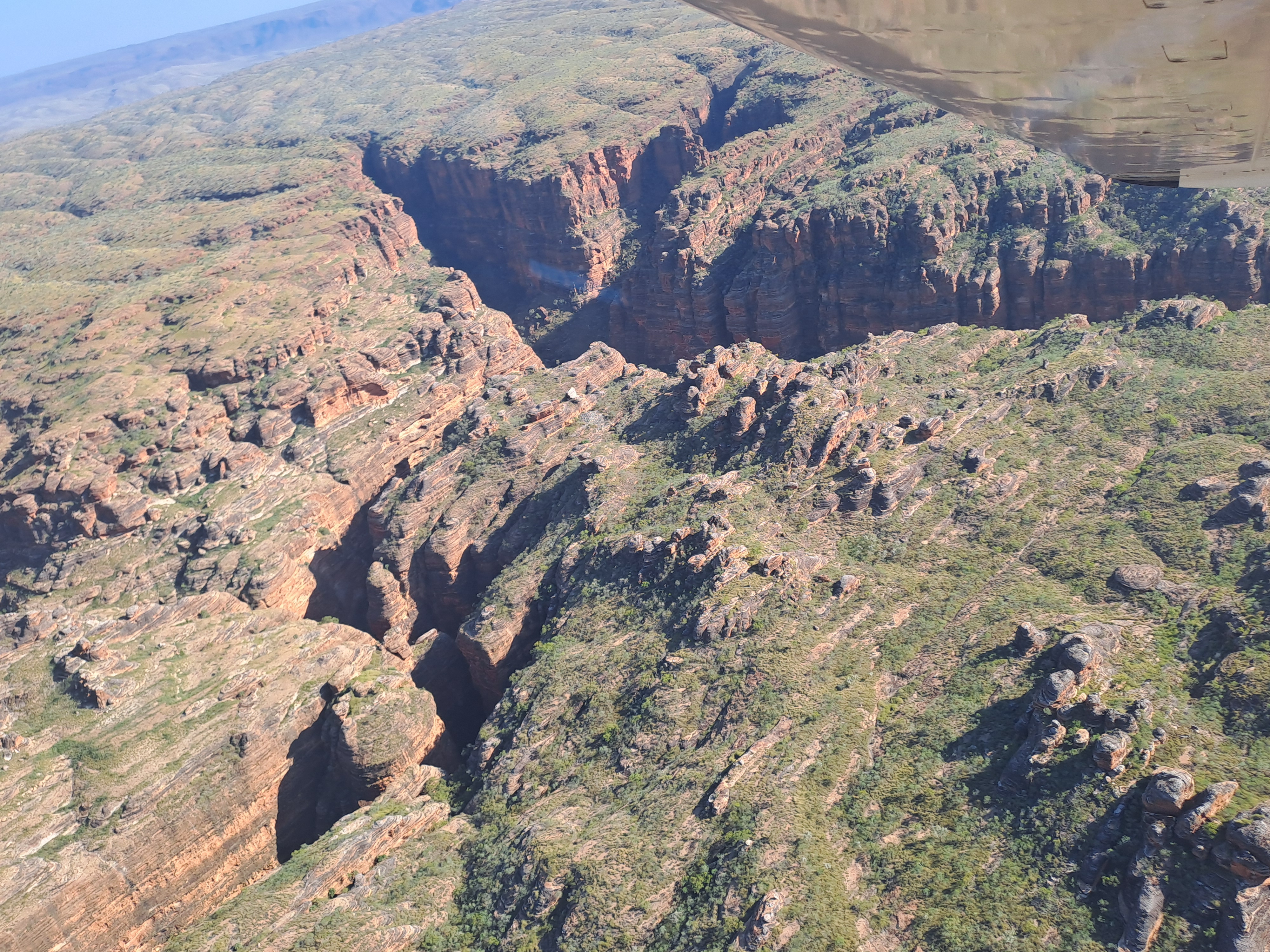
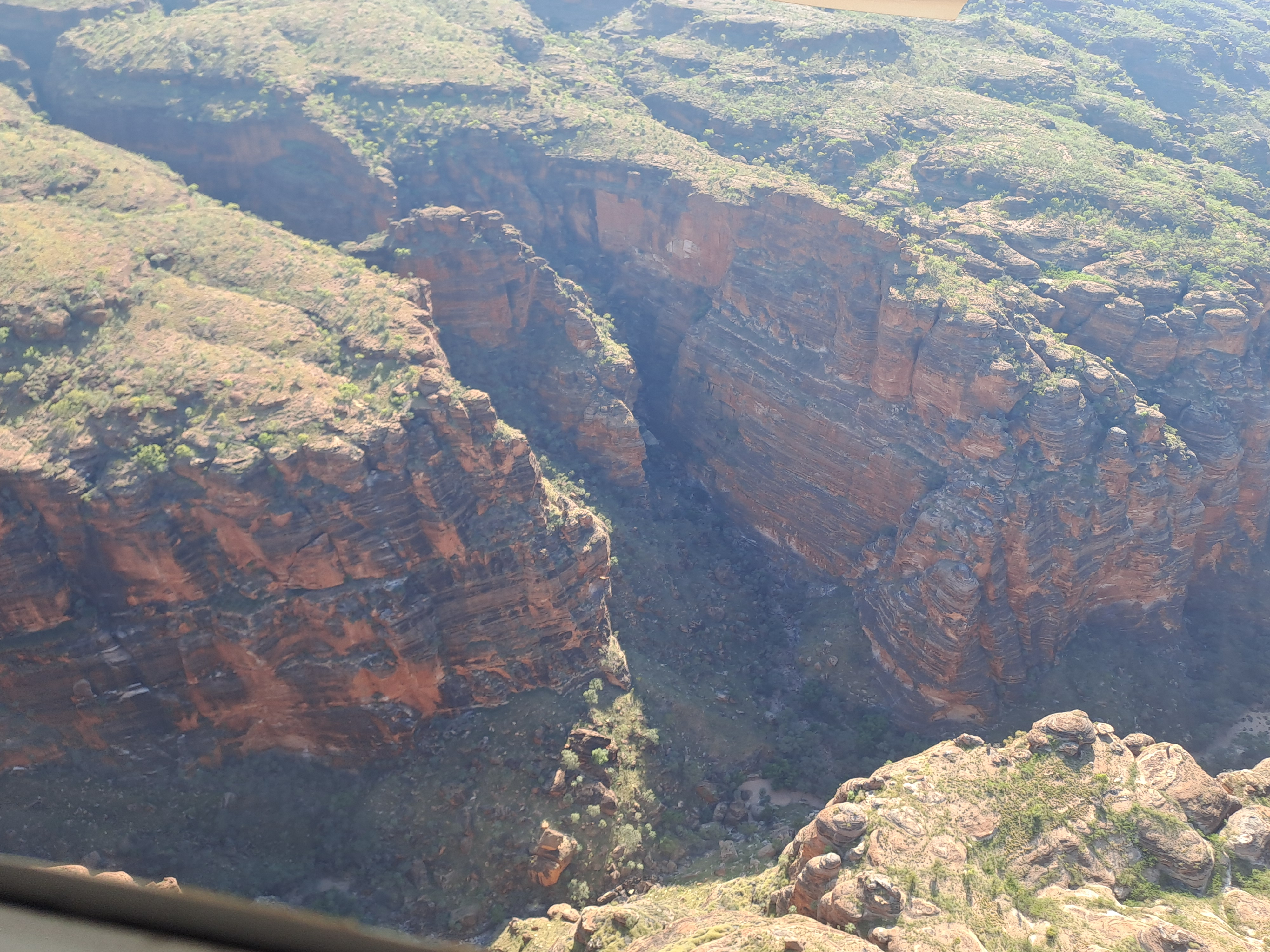
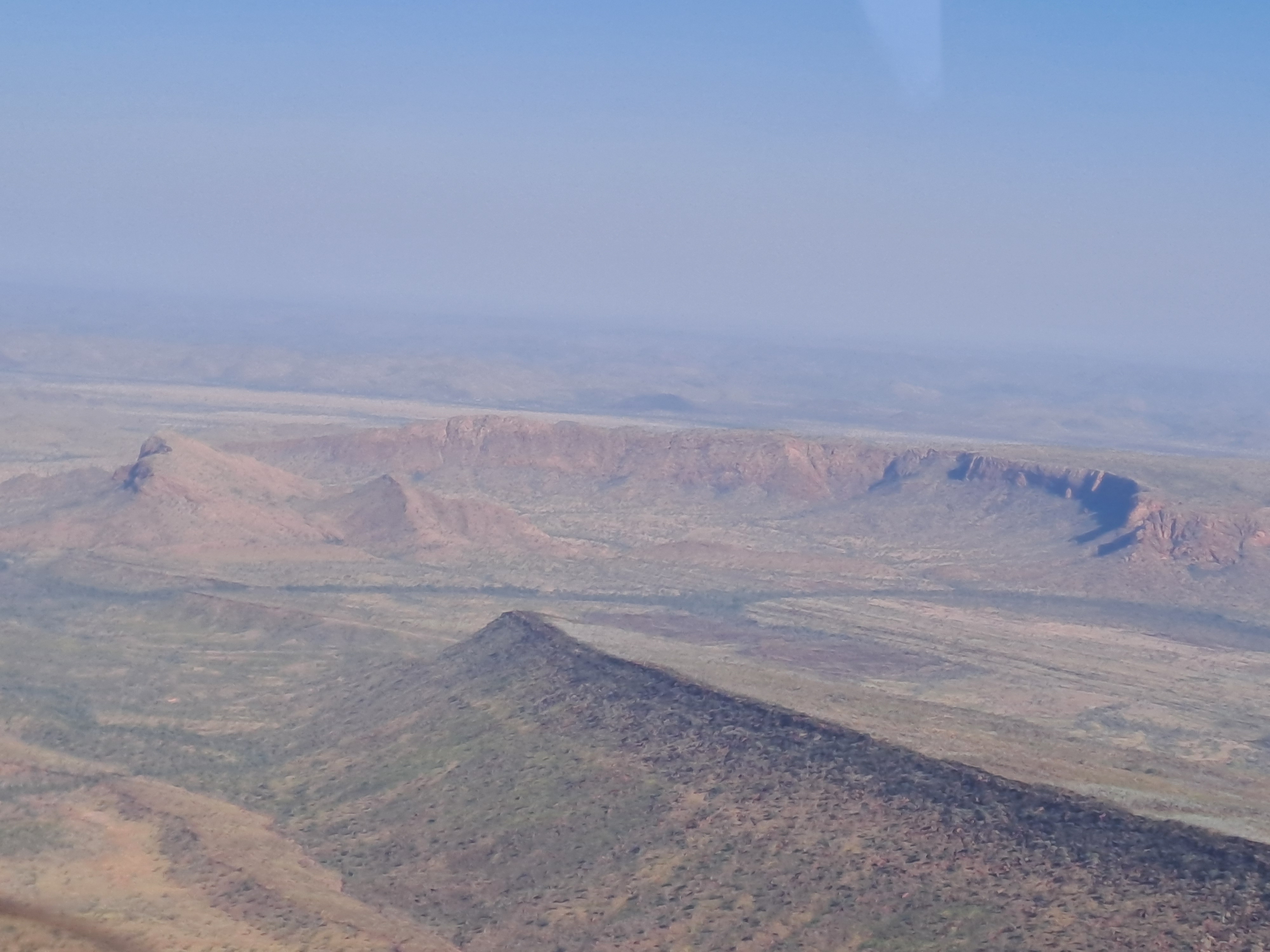
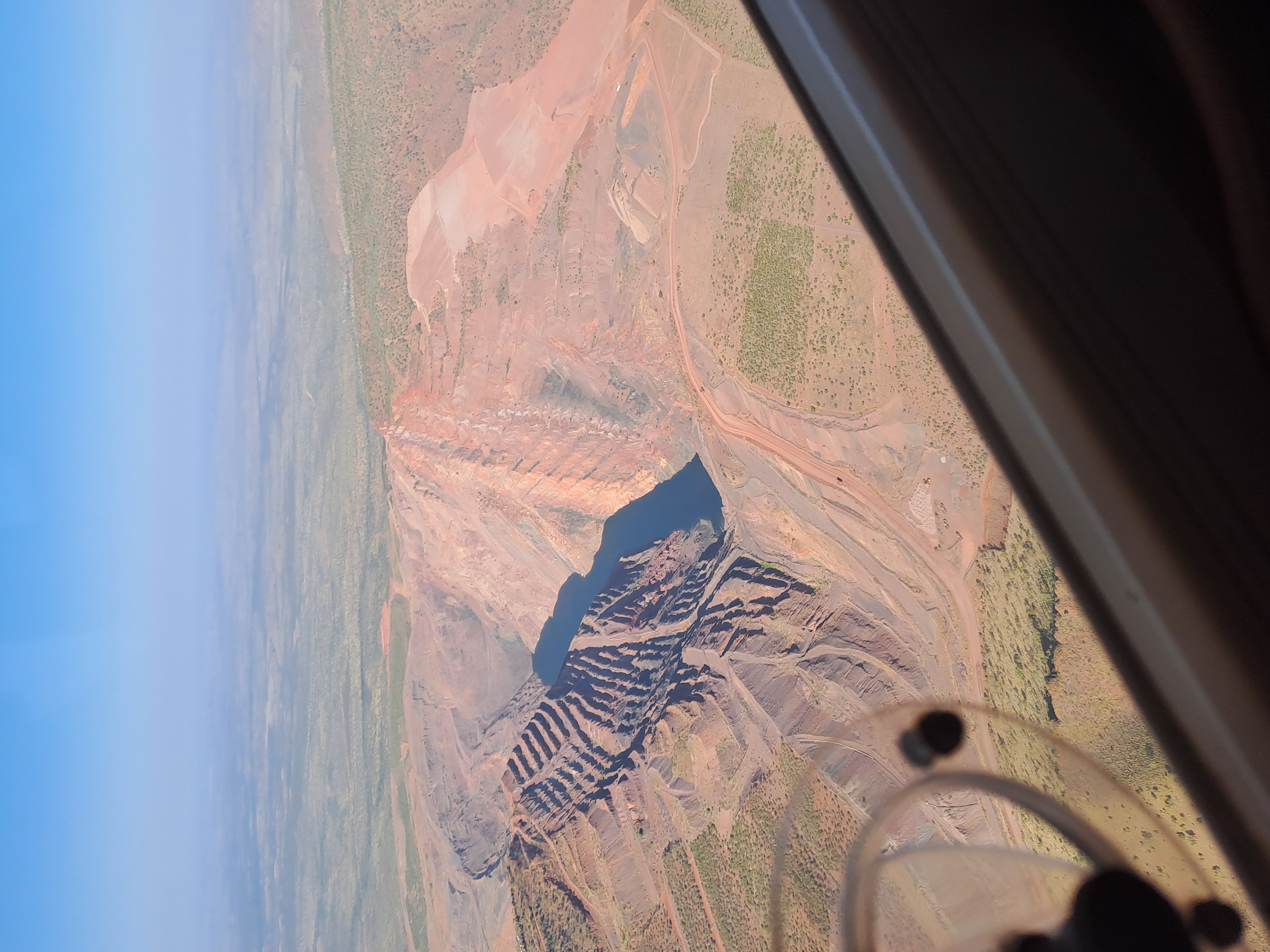
The story goes that the company with the mining rights hired a couple of surveyors to check out the area before their lease expired. These surveyors were astonished at what they found. But instead of reporting to their employers they went to Rio Tinto with the news. Consequently when the lease came up for renewal the holders weren’t interested and Rio Tinto bought the lease.
We also flew over the great farms (cattle stations) made possible with irrigation from the Ord River Irrigation project of which the dam and Lake Argyle are part.
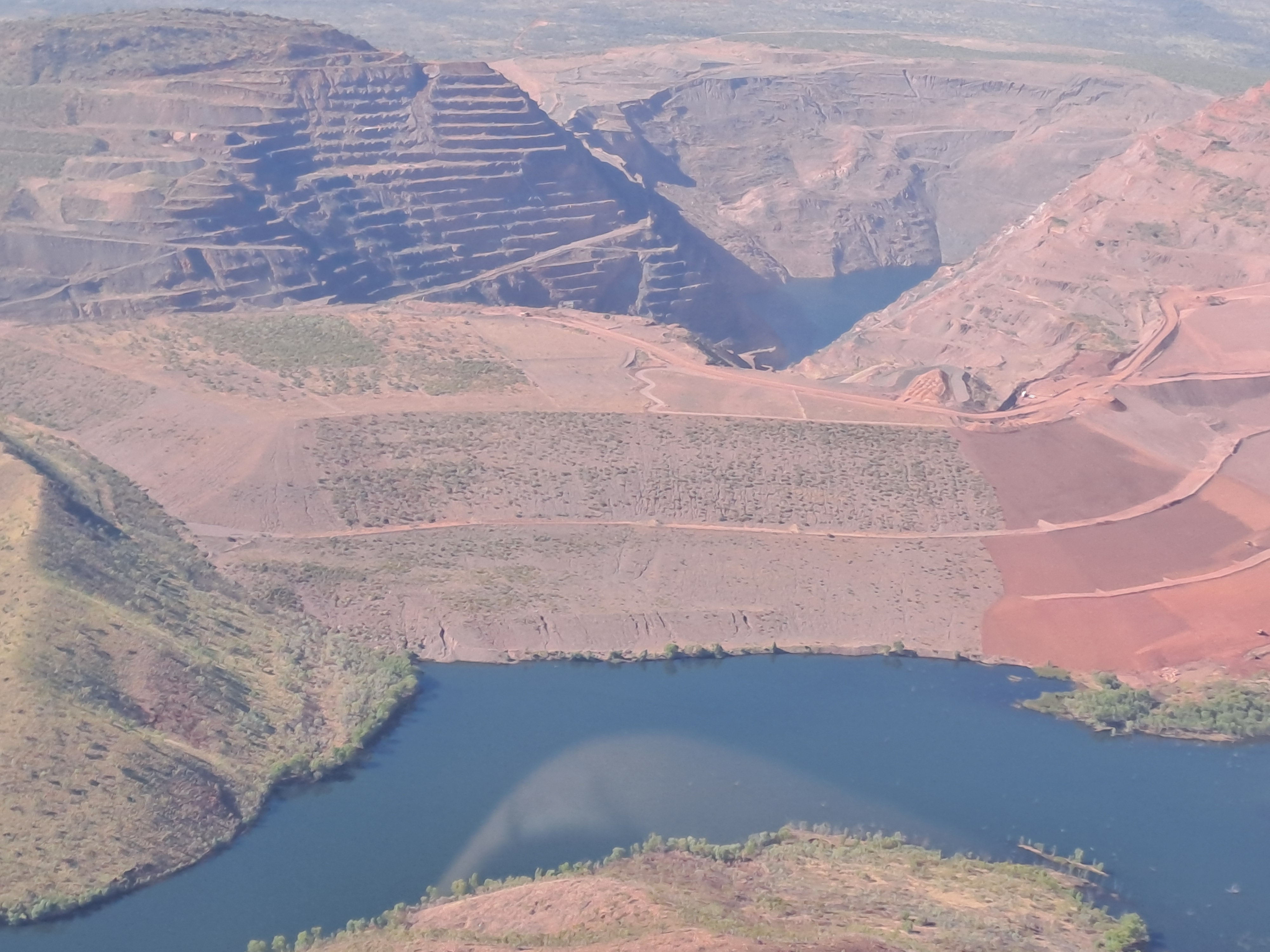

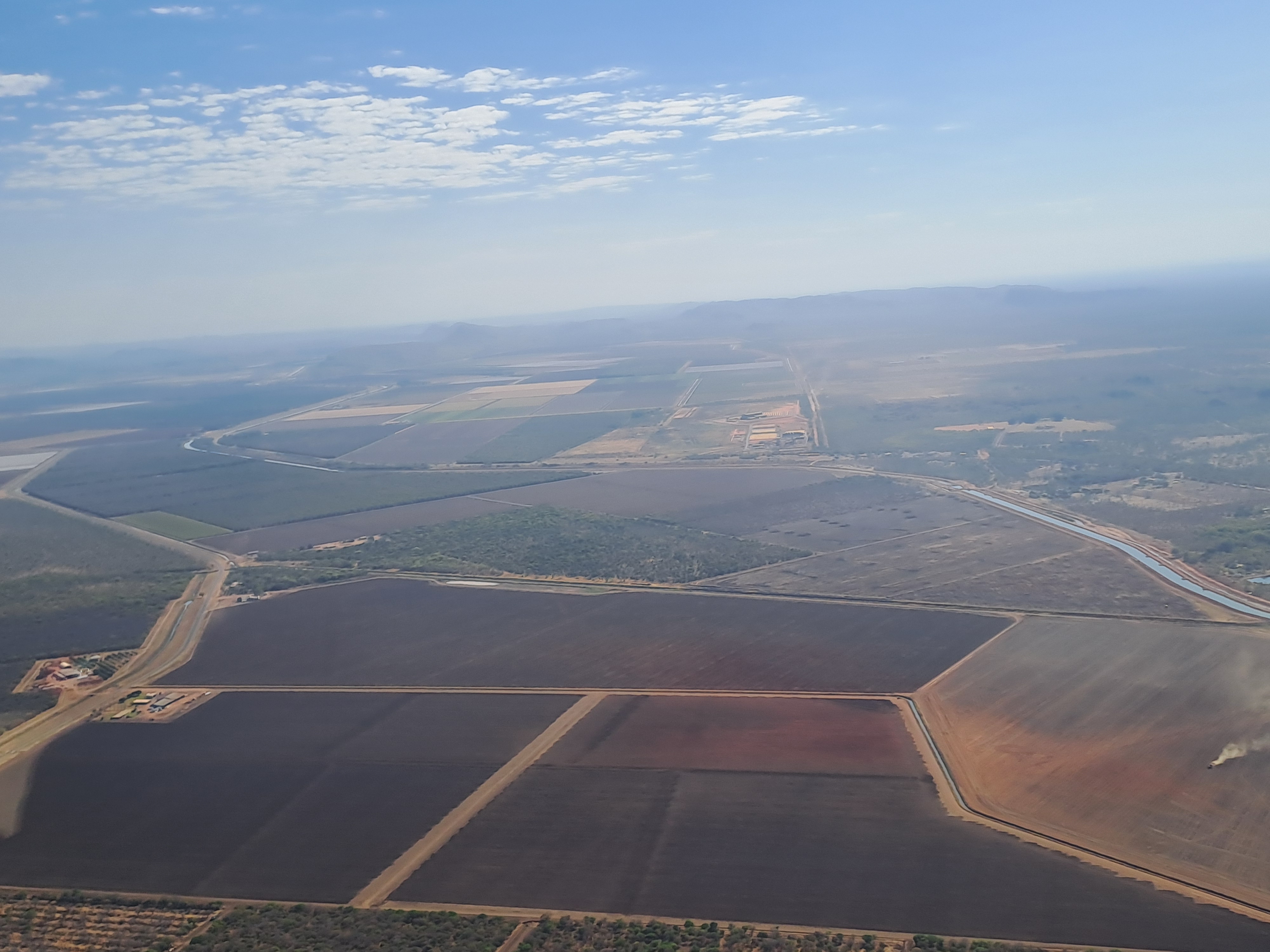

Met our pilot and plane, a six seater. On our trip there were two planes both full. We had to give our weights in when we booked and get weighed in on arrival due to the small size of the plane. Getting in and out was interesting.

After our early morning we had time in the afternoon for Kangaroo Haven. A Kangaroo and Wallaby rescue centre run from our host’s home. Her kitchen/dining area is the nursery for the babies, mainly hanging in custom made fabric pouches. Her day starts at 4.30am each day with the first bottle feed for all her charges.
Our first job was to help with the afternoon feed using a special kangaroo formula. Kangaroos and Wallabies are lactose intolerant and cows milk would make them go blind.
These animals are all brought into her as orphans mainly after road kill of mum. The company we flew with in the morning helps with transportation of babies.




We saw a variety of birds all brought in due to injury or cruelty.
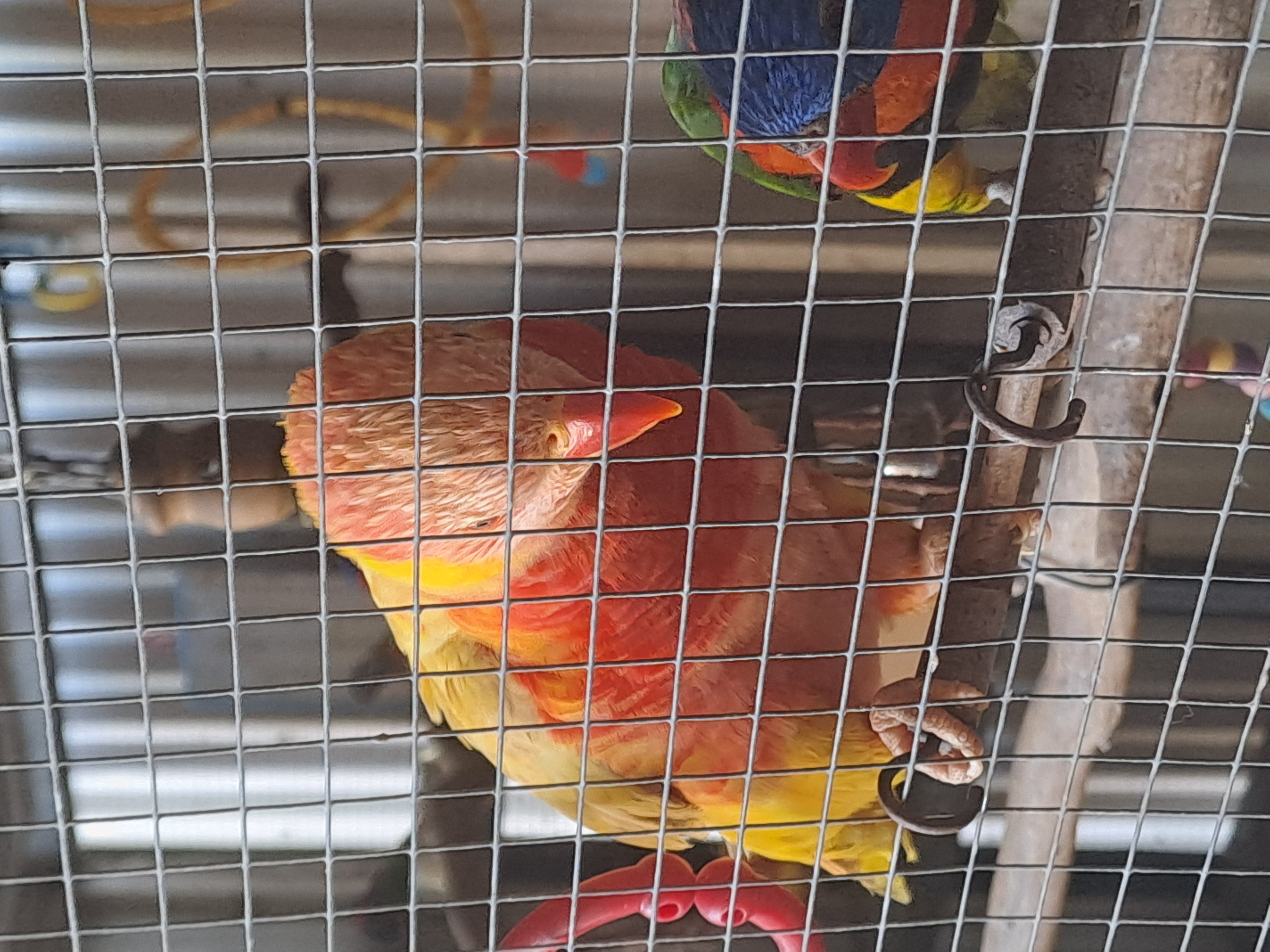
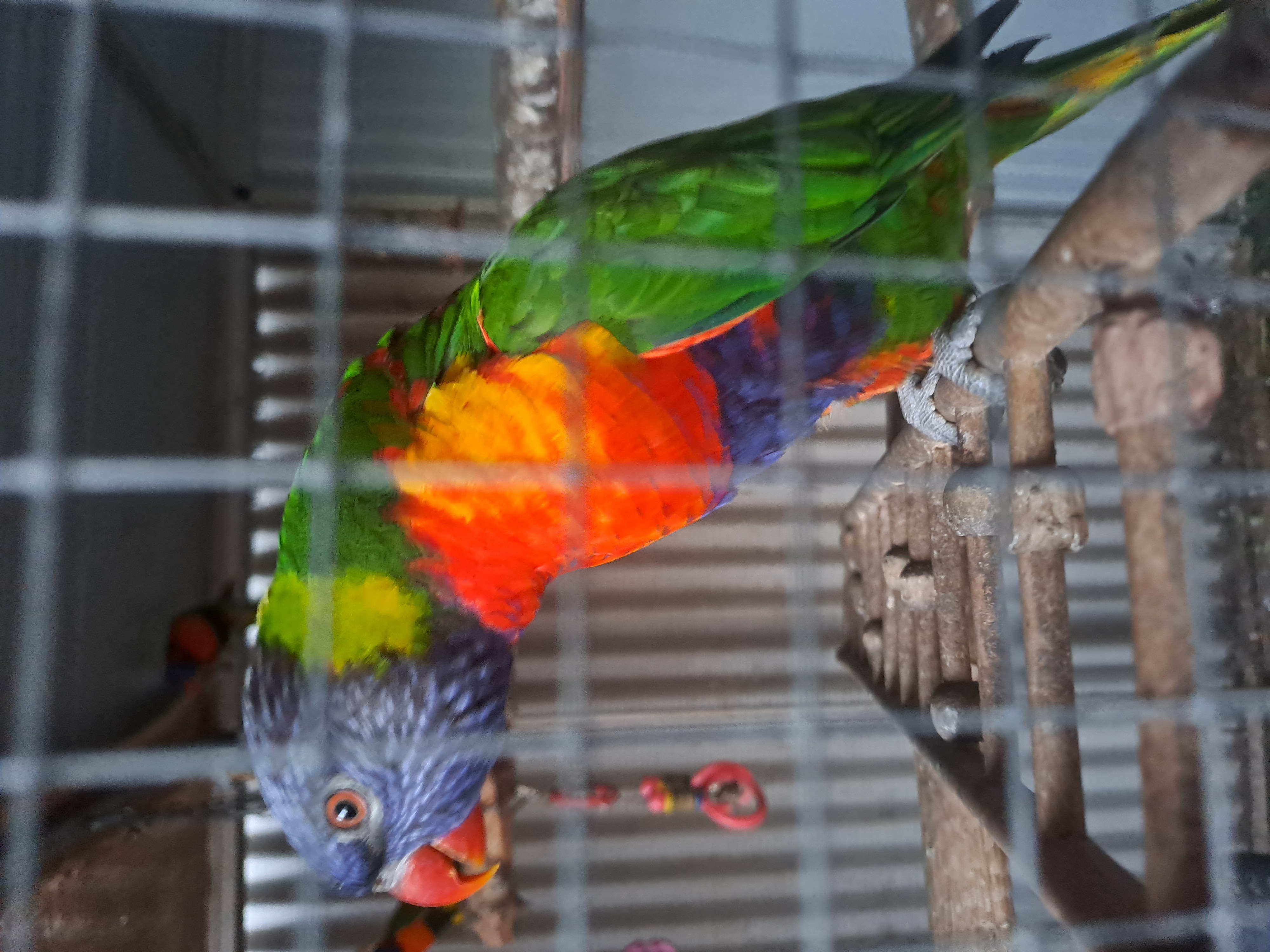


We then met the older wallabies out in the yard. These still need bottle feeding up to eighteen months. Mum wallaby has an extra set of teats that’s above her pouch so she can have one baby in the pouch suckling and another outside having a different type of milk due to their age! In fact reproduction in these animals is pretty amazing. Although the gestation period in the womb is quite short, it can be put on hold if the food supply is short. With her first baby mum grows a new vagina for baby to come out if in the pouch. This little thing, no real limbs, eyes shut then continues growing while latched on to the nipple. The baby below with mum has only just started coming out of the pouch. So mum can have one baby inside, one in her pouch and one other still breastfeeding and that one can be pregnant!
Once old enough they are released to the bush. This has to be near or in the wet season so they can find food. One pen is open to the bush and food is put out twice a day at present.
Last season the wet started early. This meant that kangaroos due to be released at Broome (they don’t live locally), couldn’t be released. Doing that journey in the wet with a bunch of animals is too risky, too much chance of being stranded. Consequently there have been a lot of pregnancys this year.
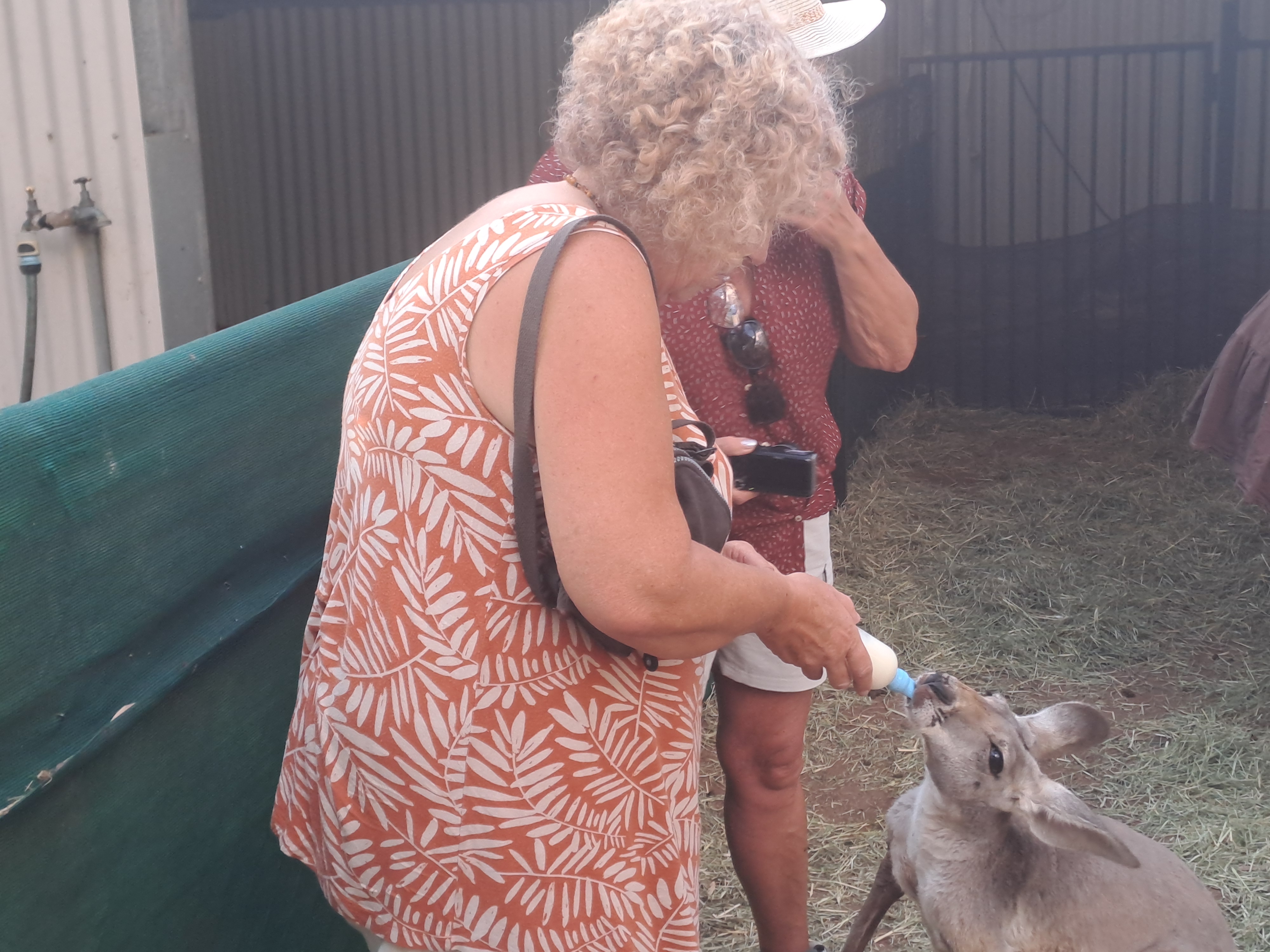
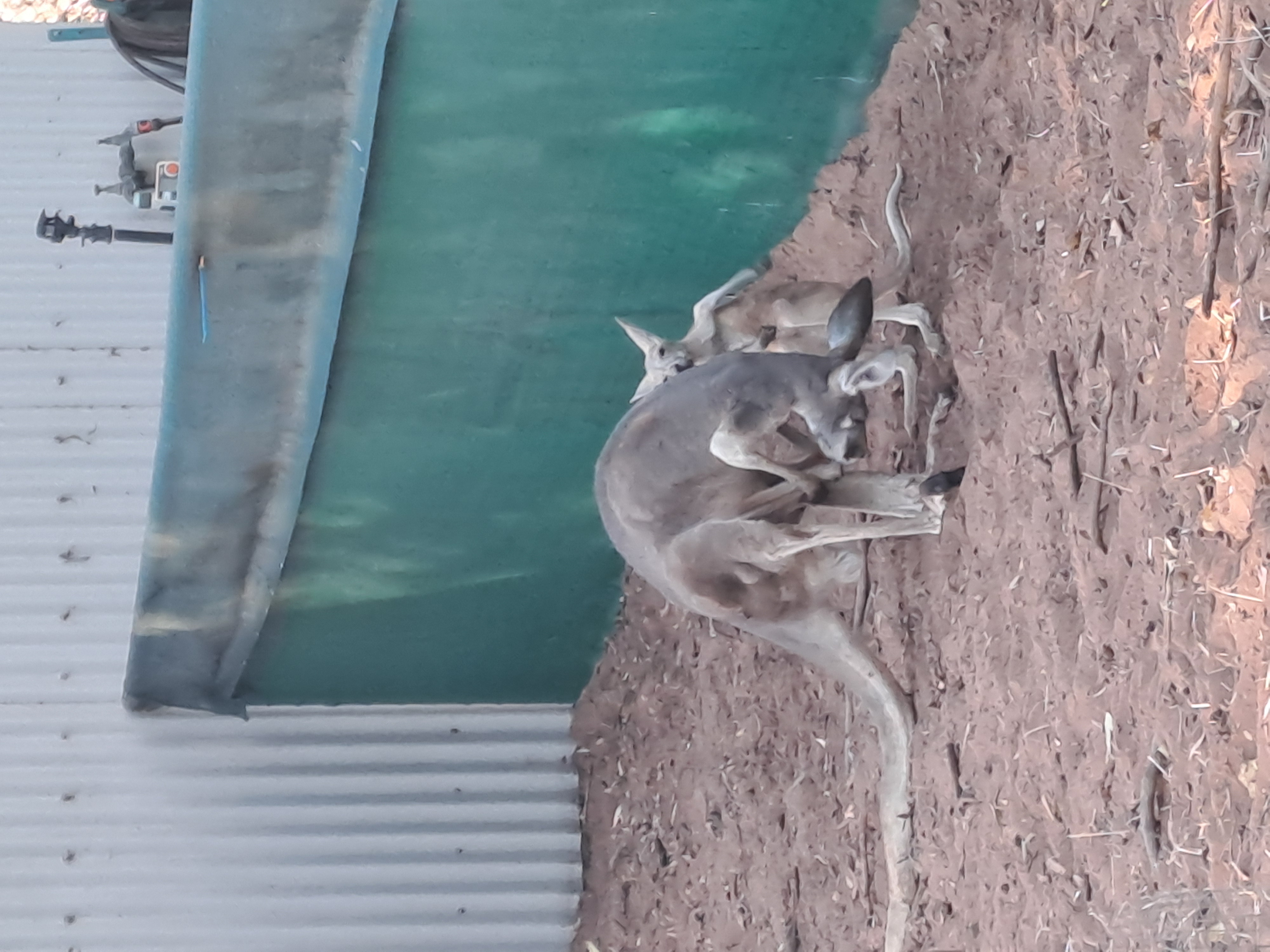
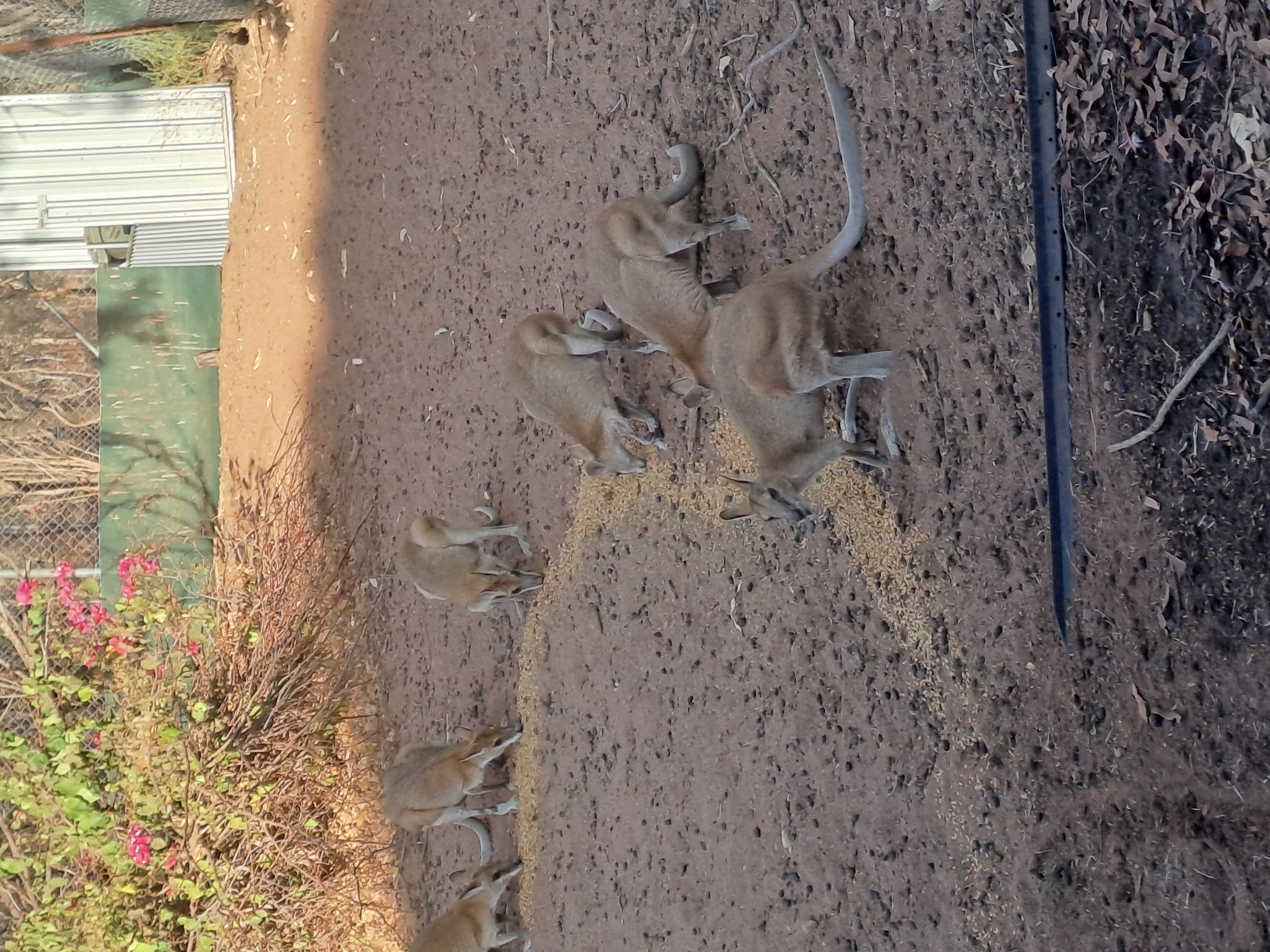

We saw more cages of birds before we went. A kookaburra, what I think is a bowerbird, and eagle and some Brolga. I had the privilege of dancing with one of these. I thought she was having me on when I started jumping and flapping my arms. However, suddenly it engaged and started wagging its neck at me before raising its wings and dancing.

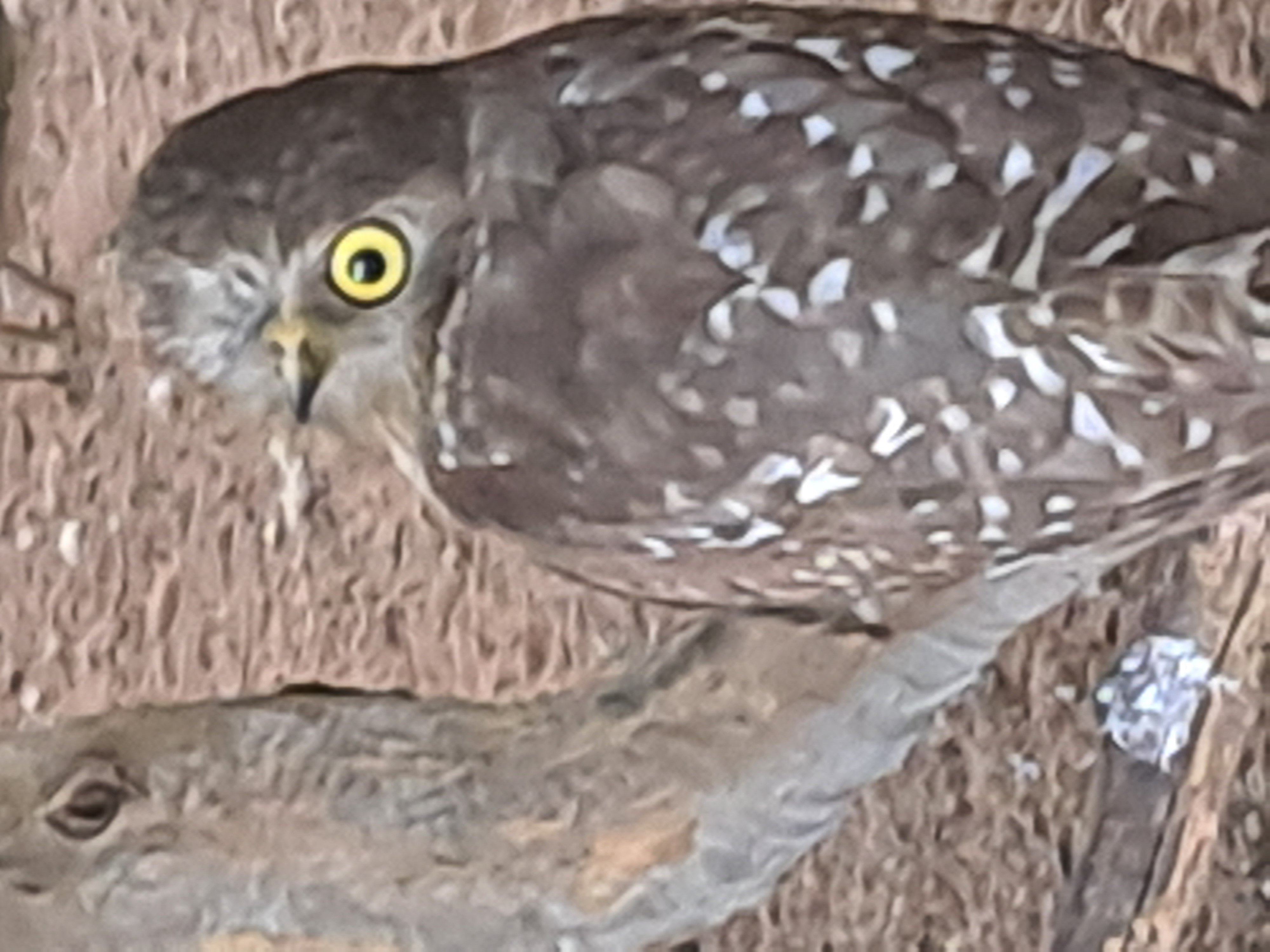


Lastly we saw a Sugar Glider which was just waking up. It is a type of possum which can glide due to skin stretched between its front and back legs.

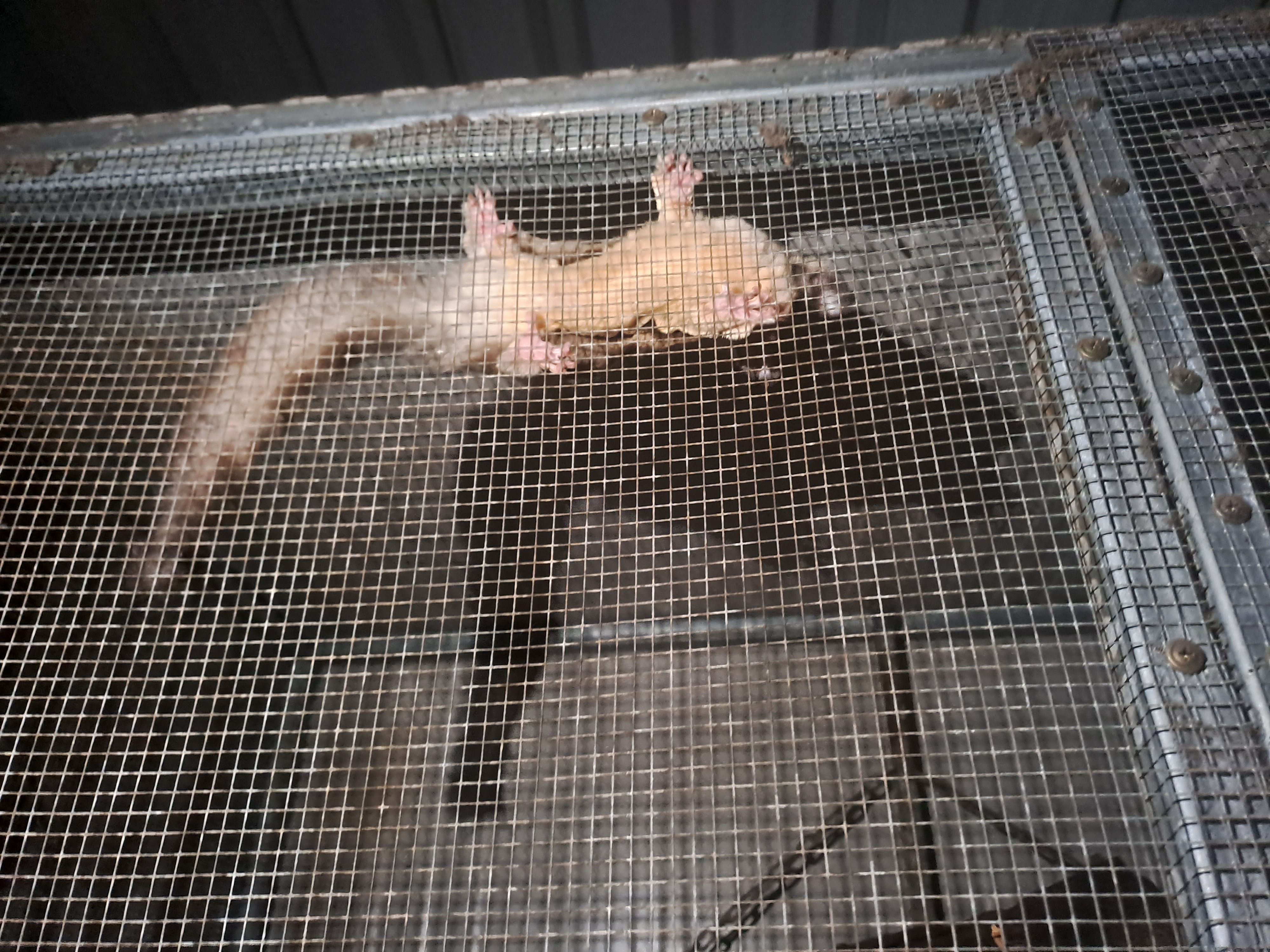
Our last day at Kununurra was out on Lake Argyle. We got picked up by coach and taken via a small museum to the homestead drowned by enlarging the lake. It highlighted the families journey from Ireland to Australia and the the decision to move over to that location a two and a half year journey with stock from the east coast.
When the lake was created so were islands on the lake. The lake filled up gradually over several wet seasons and rescue operations were carried out for the wildlife. On larger islands small colonies have stayed and we observed some of these rock wallabies.


The lake is also home to approximately 25,000 fresh water crocodiles. It has created an entirely new habitat and allowed the population to expand in line with this.
We only saw a small part of the lake on our trip it is too huge. It is more like a small sea, 42 miles by 6 miles.
Although today the lake was calm, in the wet season it can be very choppy with big waves. To pilot a boat here you need a skippers licence as it can be dangerous.
Currently the potential of the lake is under utilised however there are continuing projects for irrigation and developing the potential. So far there has been experimentation with different crops for the best success.
The lake temperature is around 28 degrees which is comfortable for people and crocodiles, but the crocs need to bask as well.
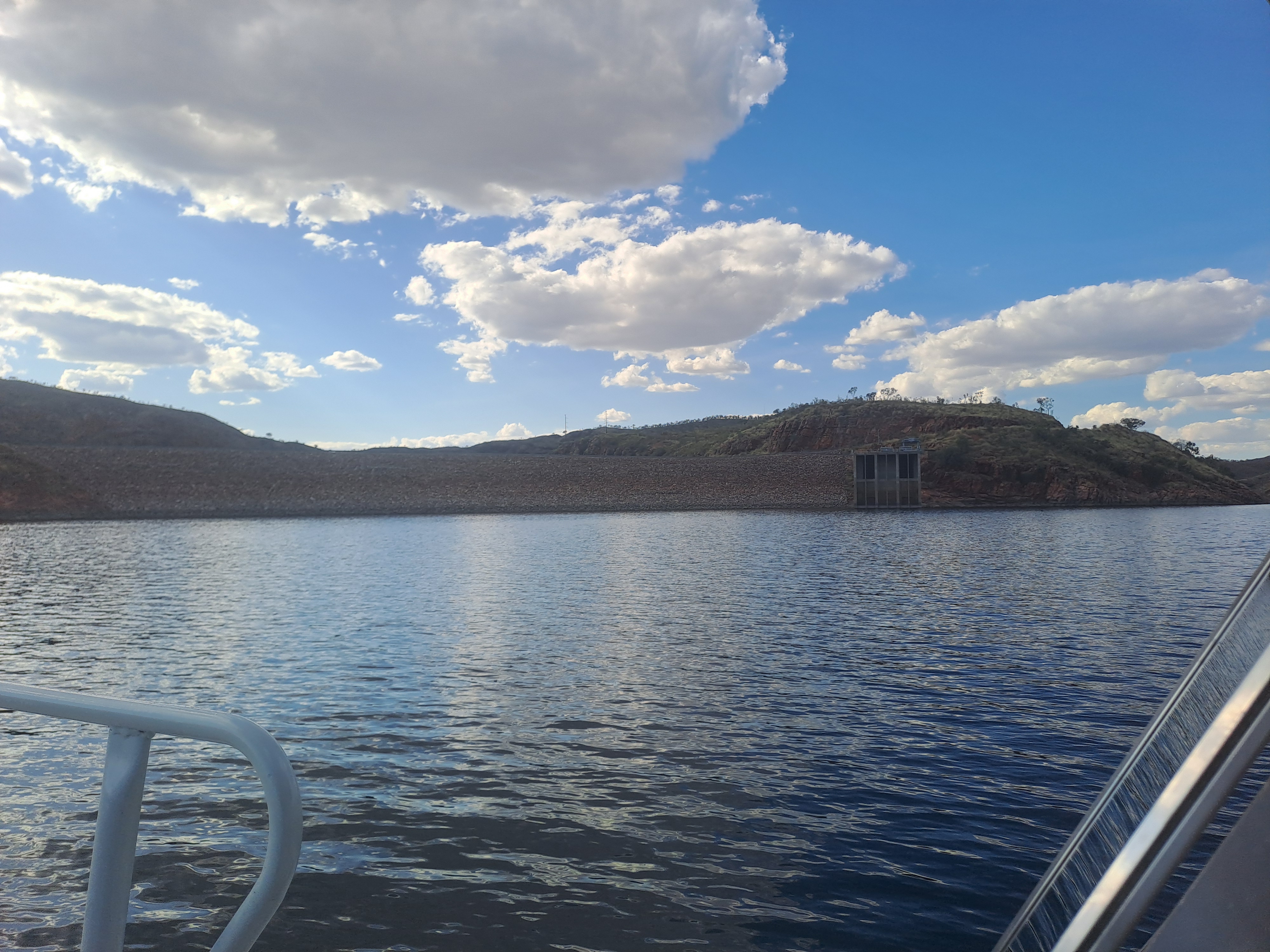
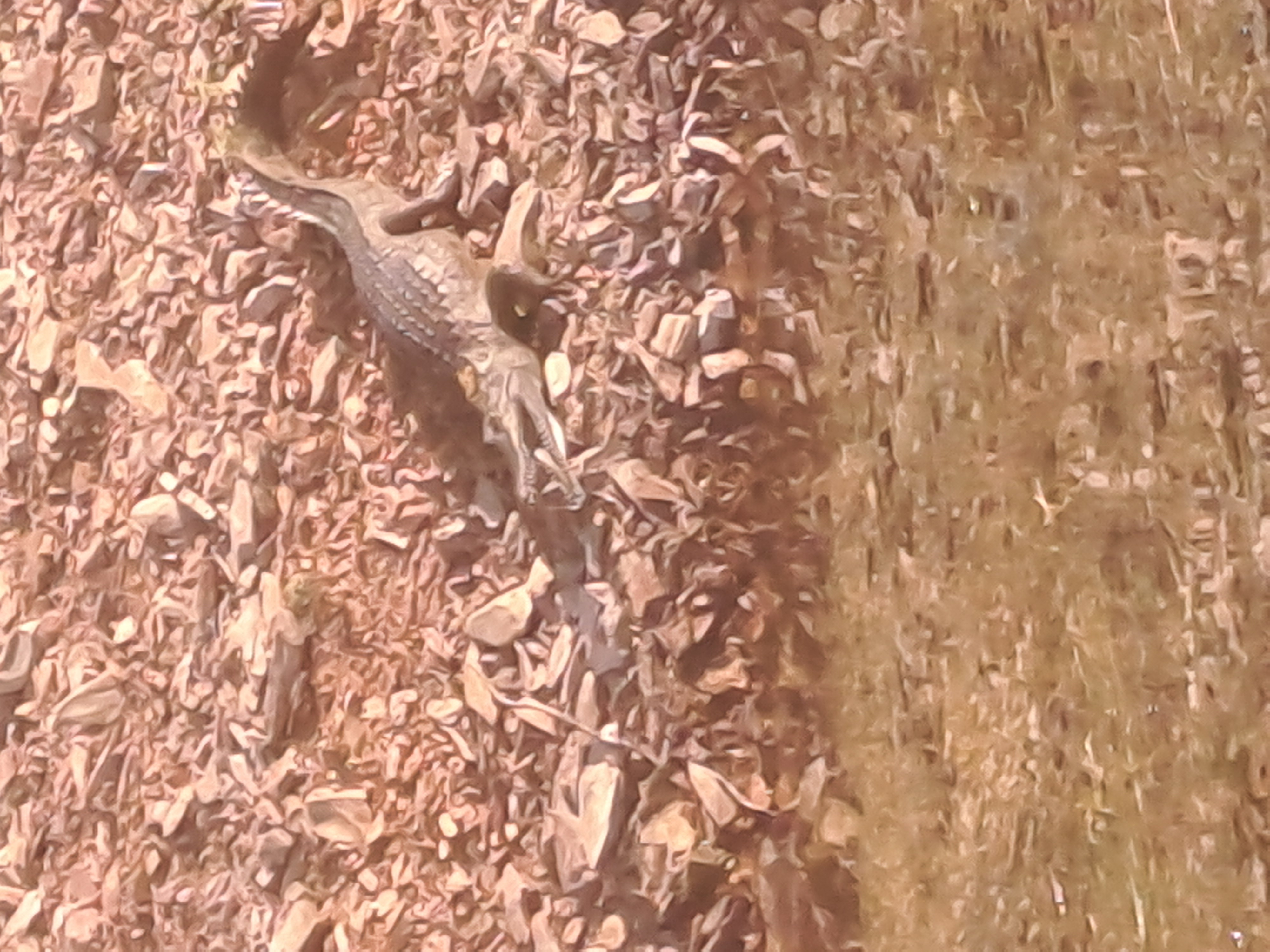
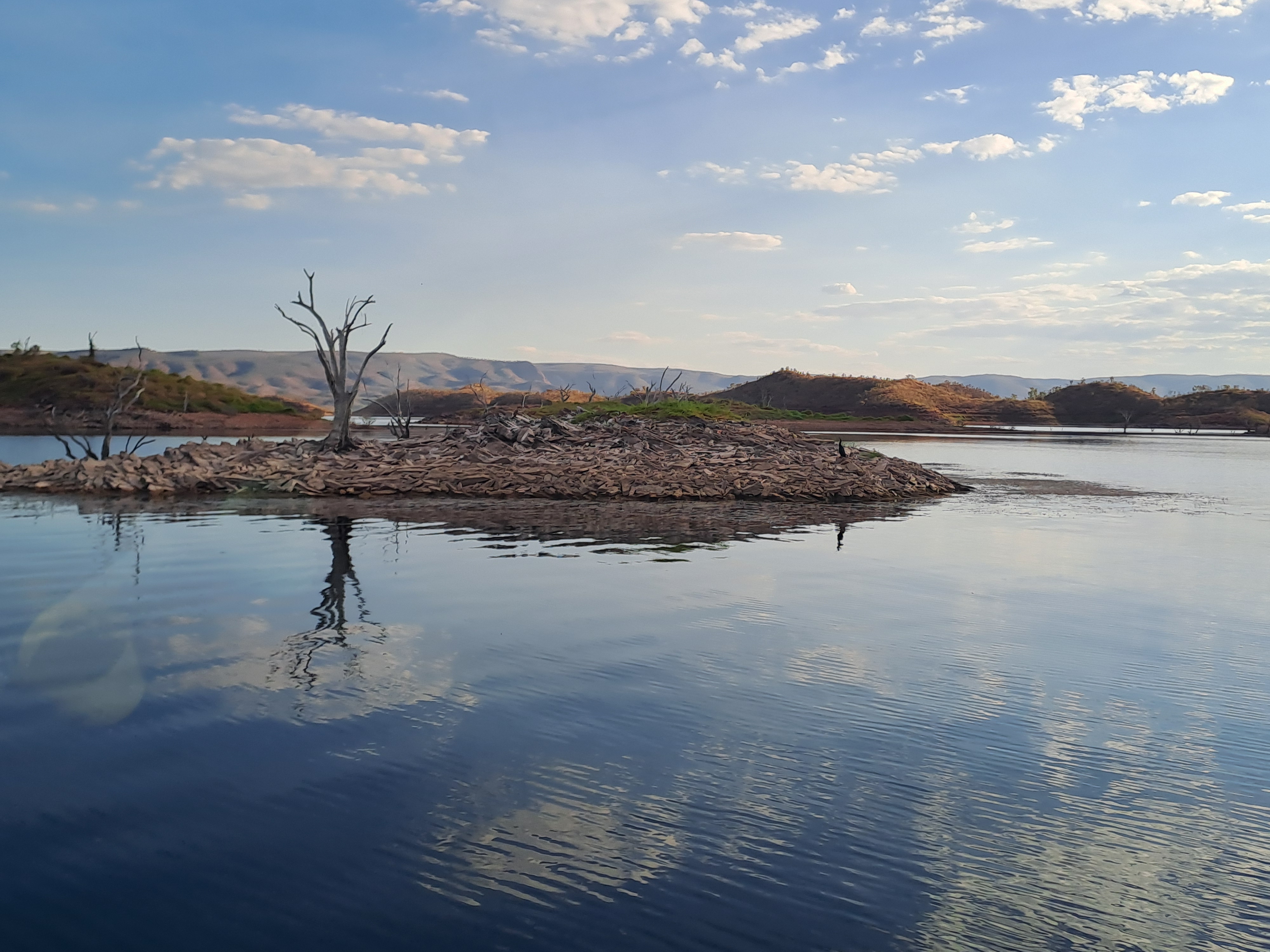
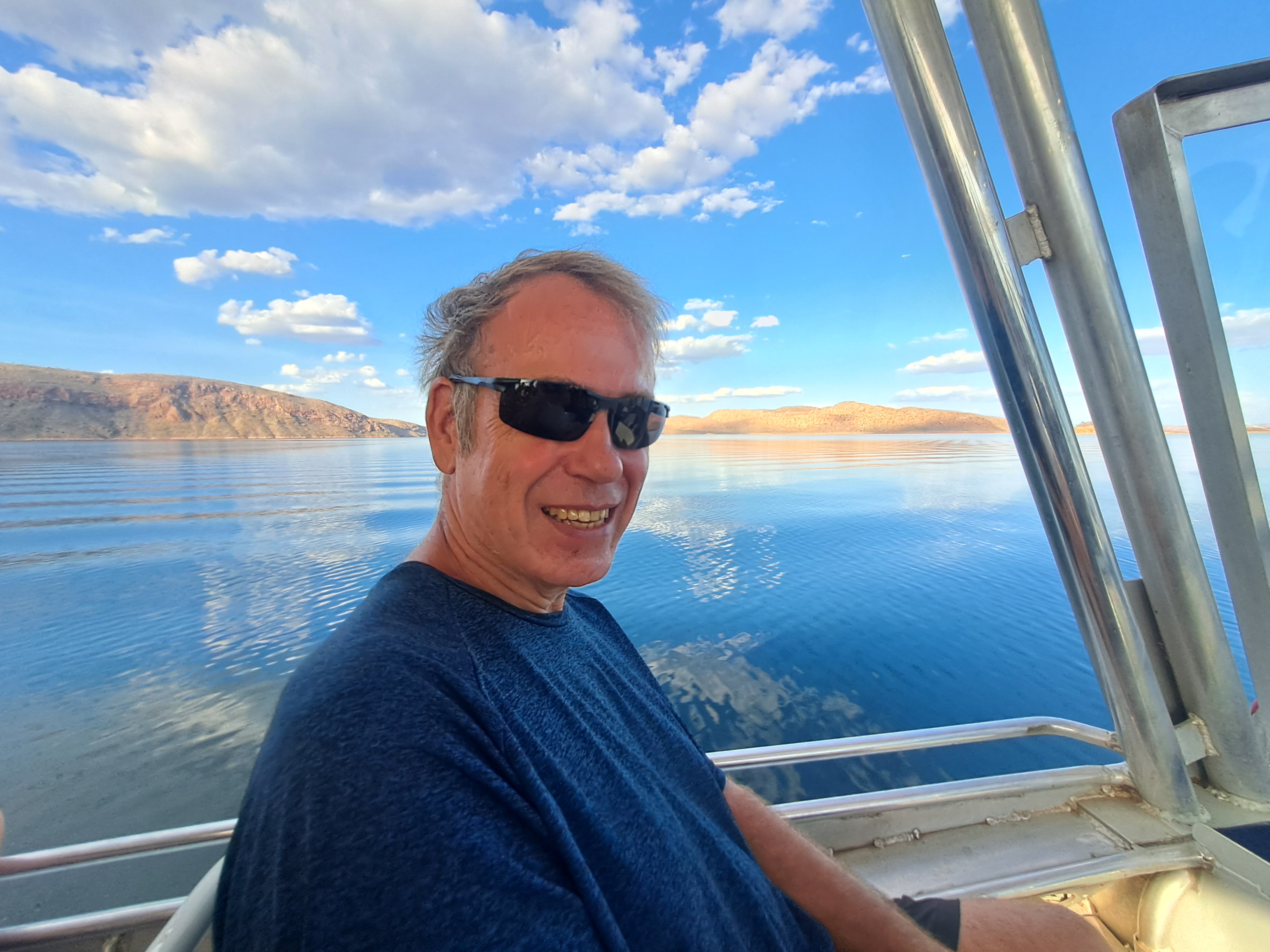
As the sun went down we enjoyed the beauty of the lake.
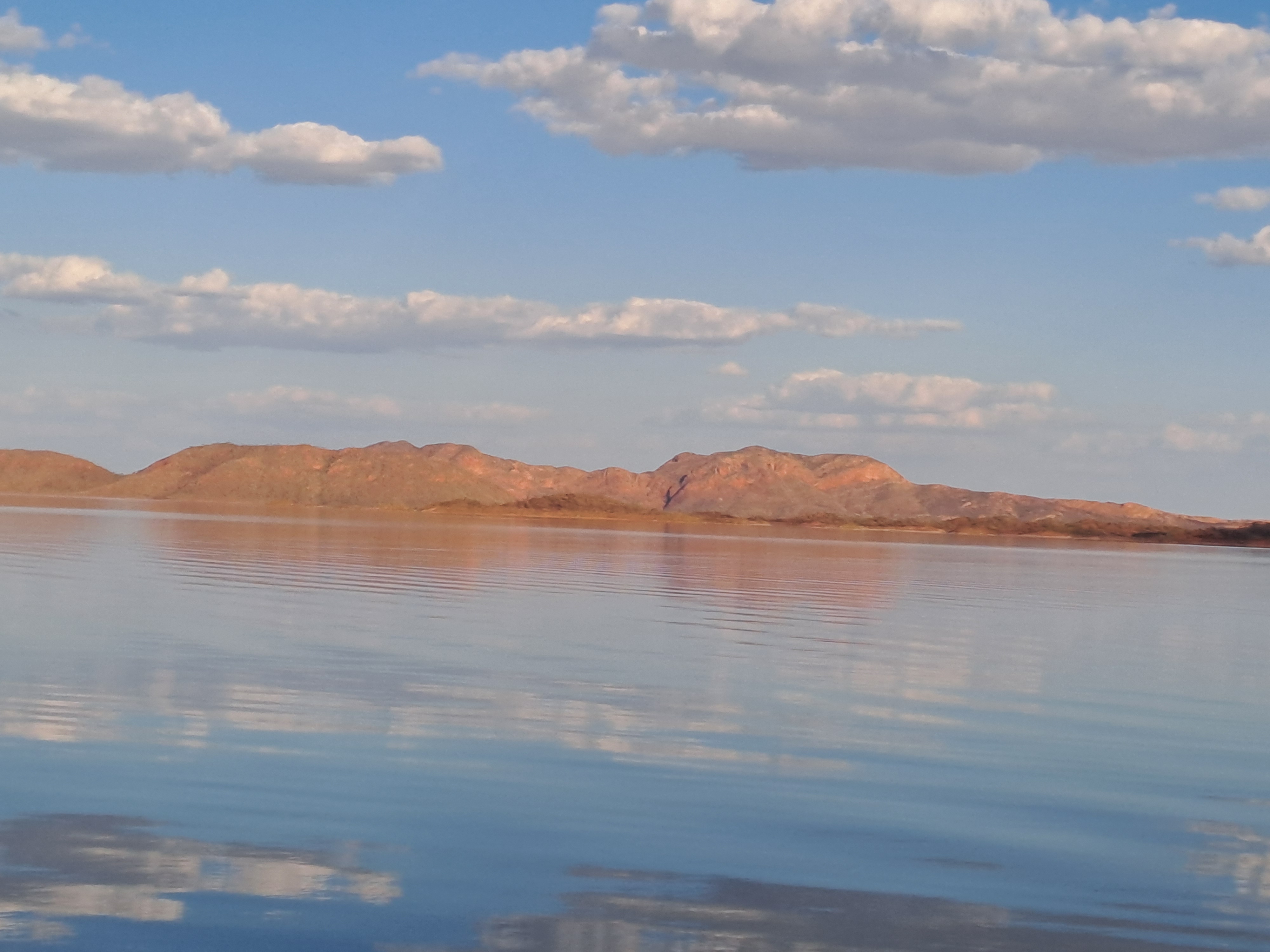



We then had an opportunity for swimming and amazingly drinks in the water along with crackers, floated out to us on polystyrene. What a memorable experience, absolutely magical. A stunning end to our stay at Kununurra.
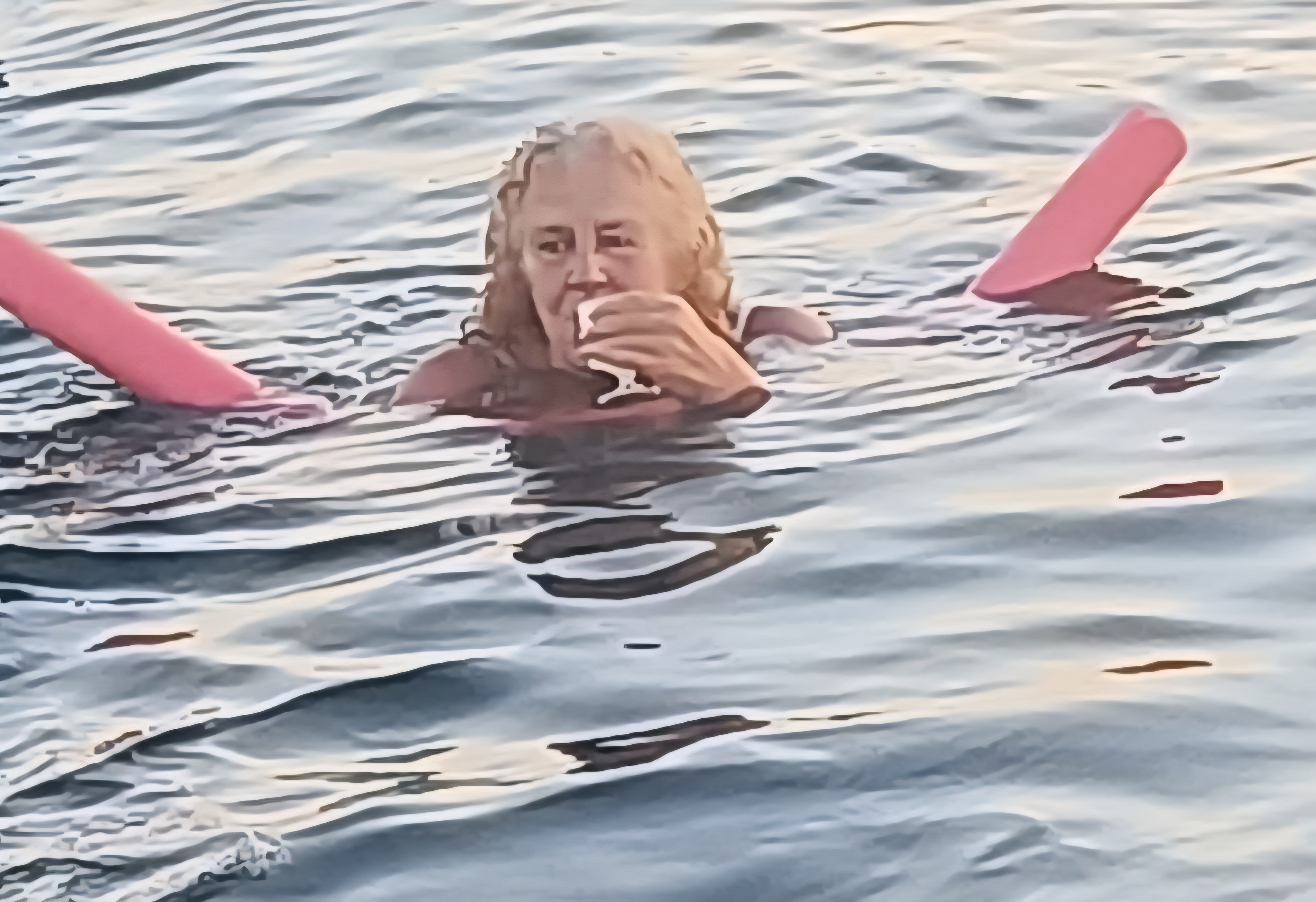


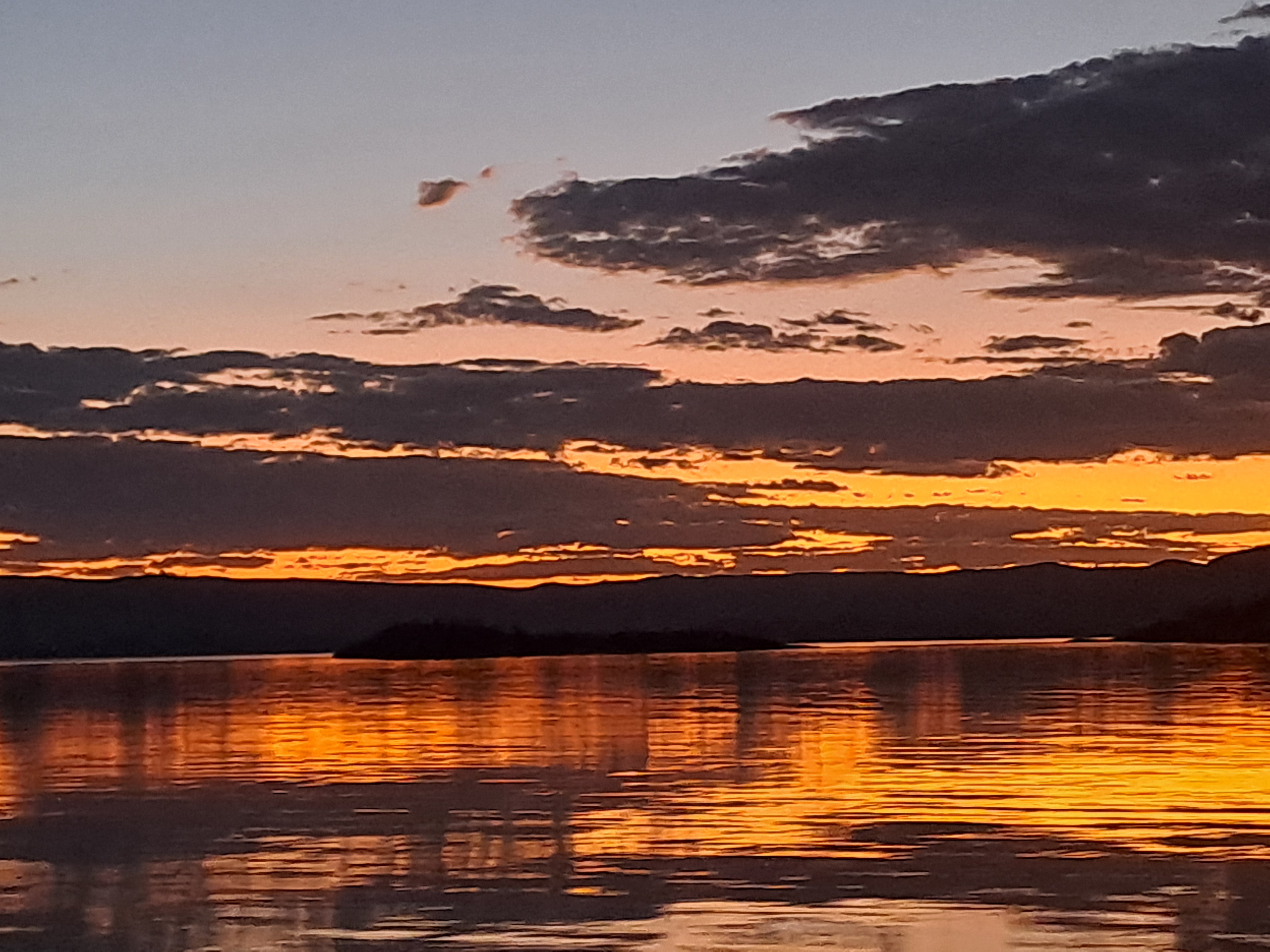
We had been due to go to the Bungle Bungles next however, as that was cancelled we opted to just travel to our next place of interest via a couple of stops ( all the distances are long here).
After the first Roadhouse (petrol station with shop, camping ground, sometimes pub or restaurant) we were due to go to a free camp, however a site with a swimming pool, showers and cold lager was infinity preferable so we drove on past our next planned destination to Fitzroy Crossing and found ourselves at Octoberfest. Presumably held at the end of September as the season ends then. Instead of the festivities, after a swim and a couple of beers we headed back to our site and the fish and chip takeaway van.
The whole design of the site is based on the expectation of flooding. The hotel rooms are on stilts, the amenity block on a raised island and reception also on a raised island. The bottom picture shows why. All the brown stuff is water. You can just make out the bridge over the river. At the time of our visit the river was a dry bed.



Next day we went back on ourselves to Mimbi Caves and the attached campsite. This was very isolated, however, the site was well set out with good facilities and we enjoyed our peaceful stay there. Just two other vehicles with three people, again, the end of the season.

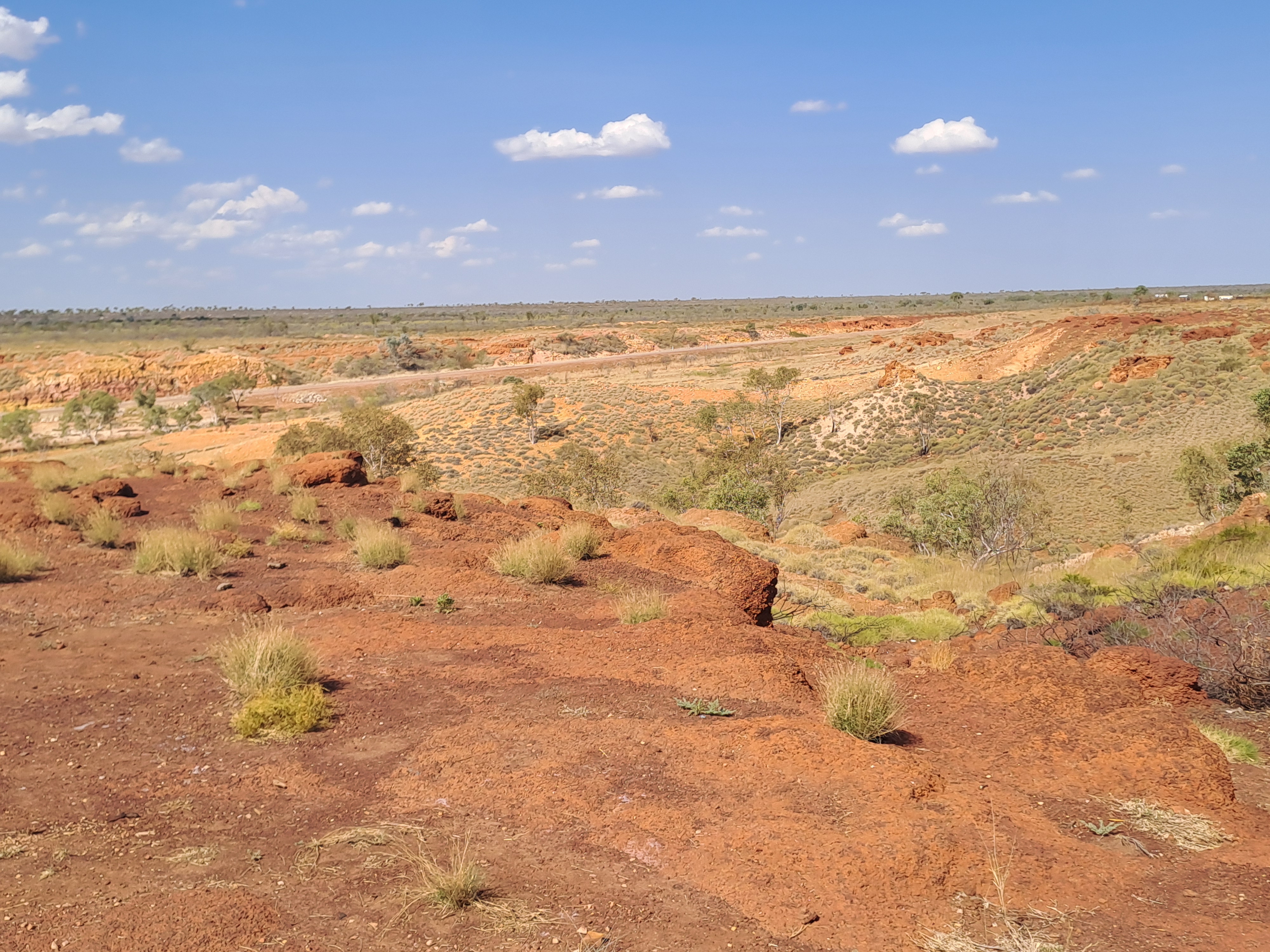
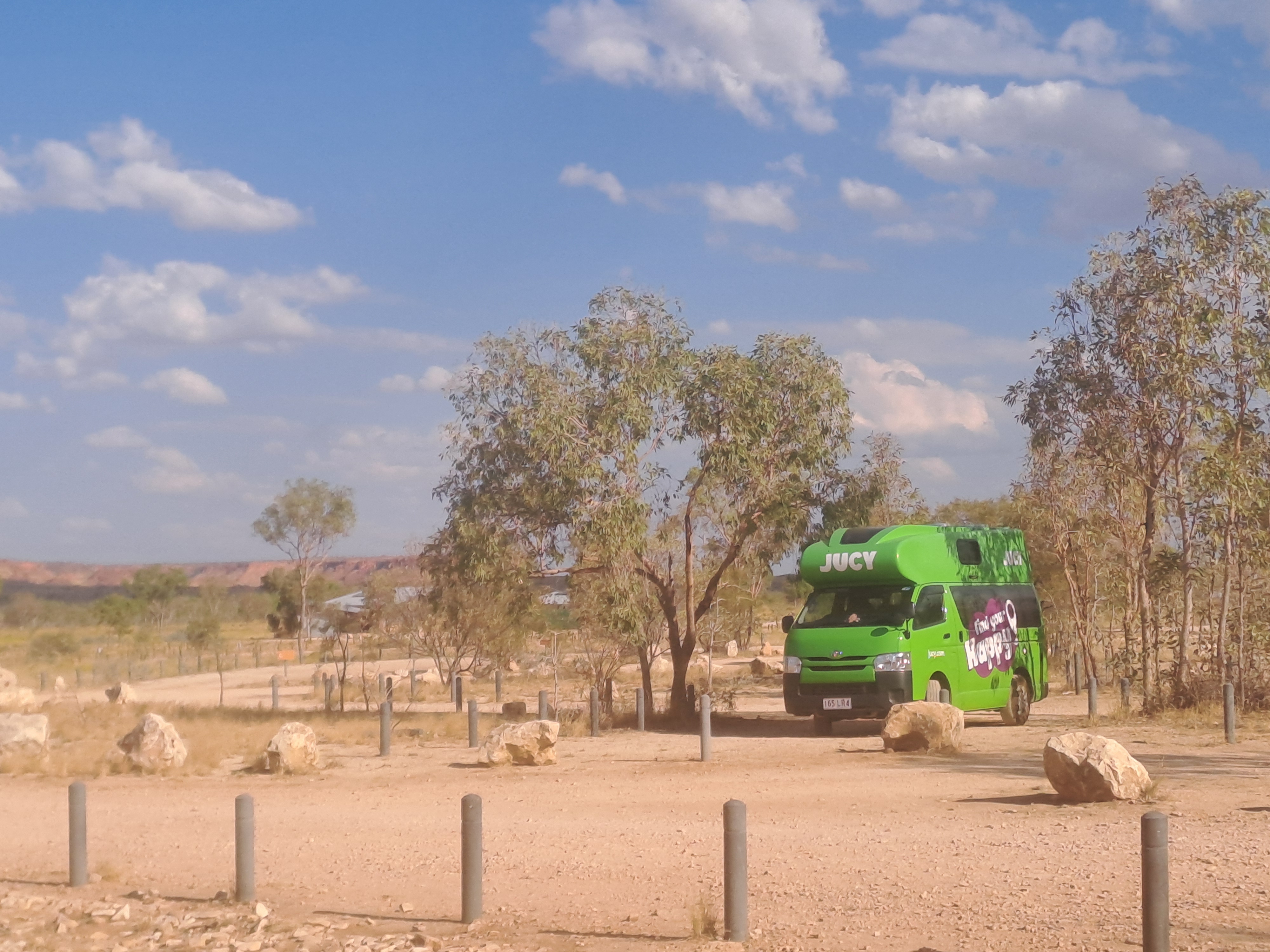

The caves are part of the Aboriginal cultural heritage. With their own significance in both beliefs and use. They have been used as a hiding place for safety and for swimming and playing. They have not been altered at all or made easier for tourists with handrails, as it is felt this would take away from the cultural heritage.
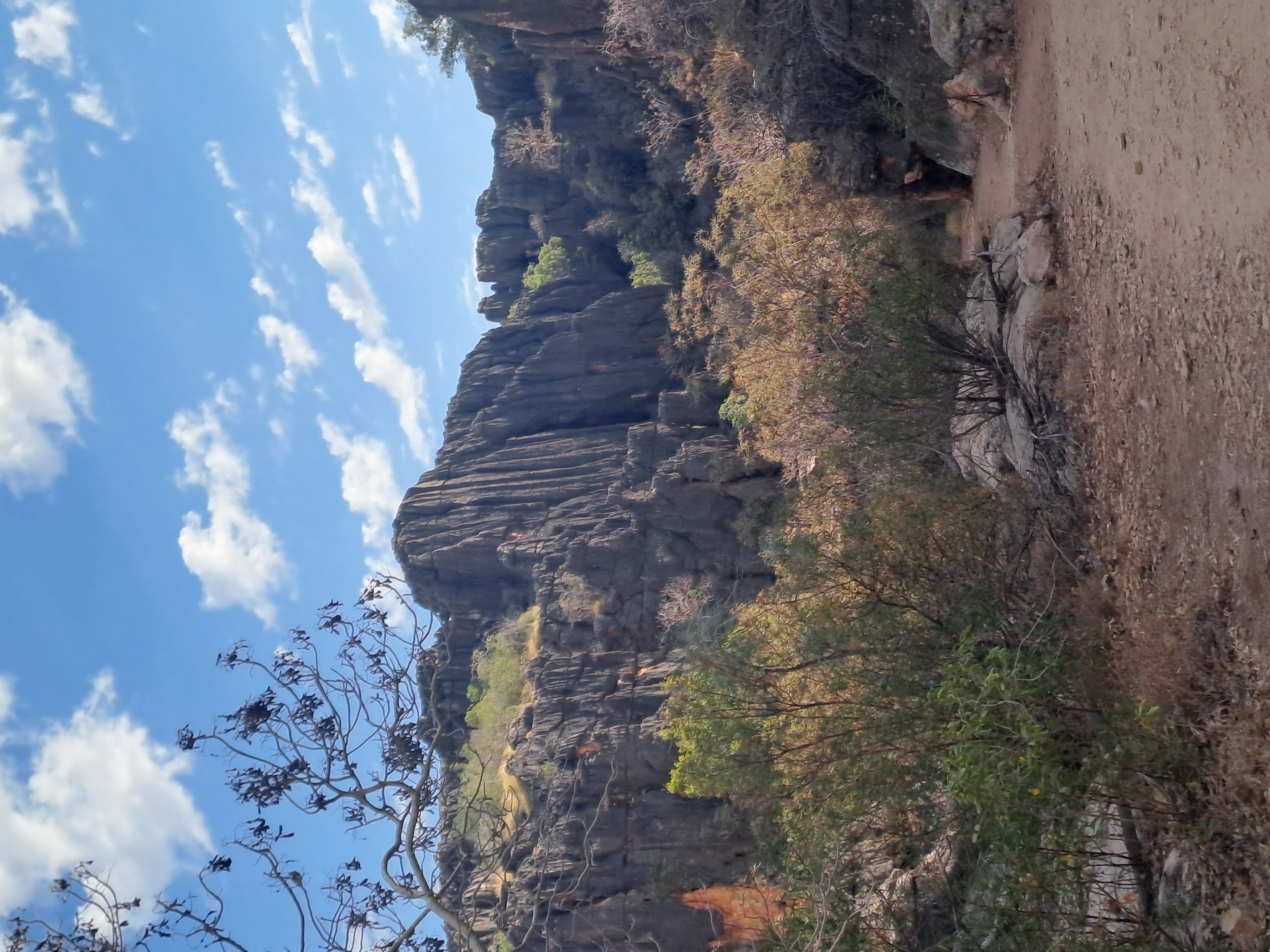

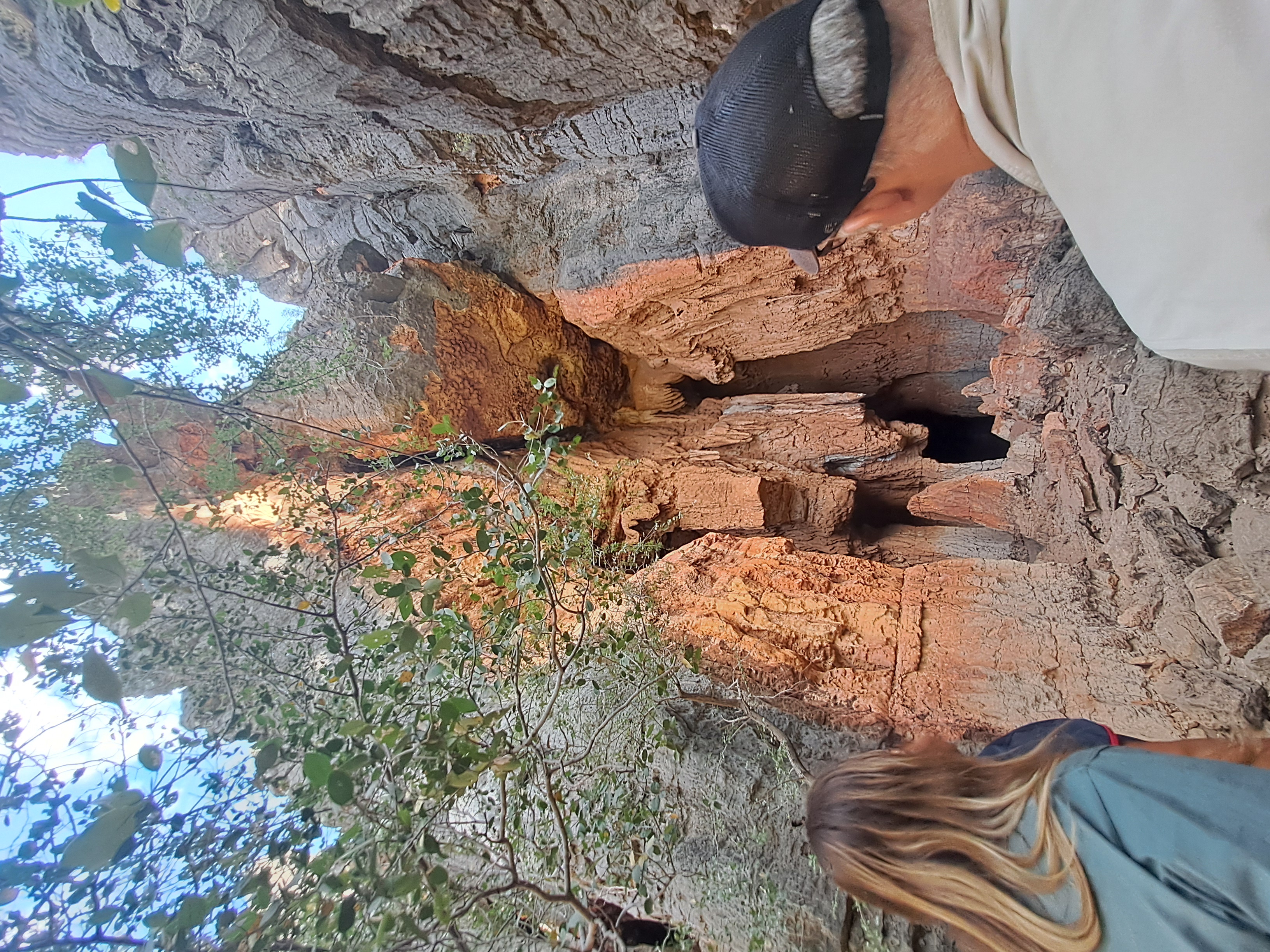

We saw micro bats ( below) and a feature looking like a pregnant woman. Women often come here when they want to get pregnant
We were told about the rainbow snake who made the caves and the blue tounged lizard.
At the end if the tour we had the option to swim out through the cave. We should have had damper and billy tea after, but being the end of the season everything is being packed and moved to higher ground for the wet season when the caves will be flooded.


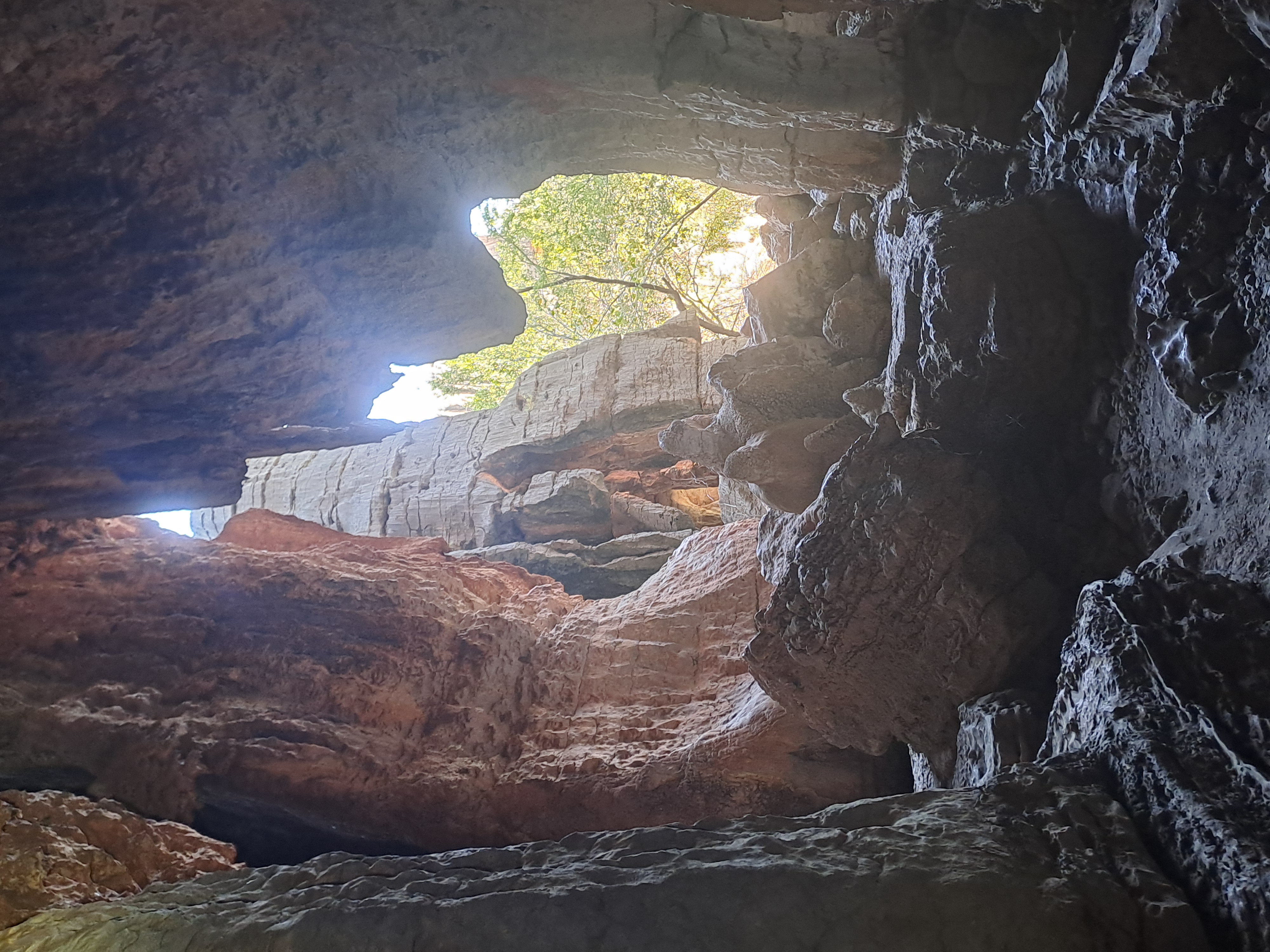
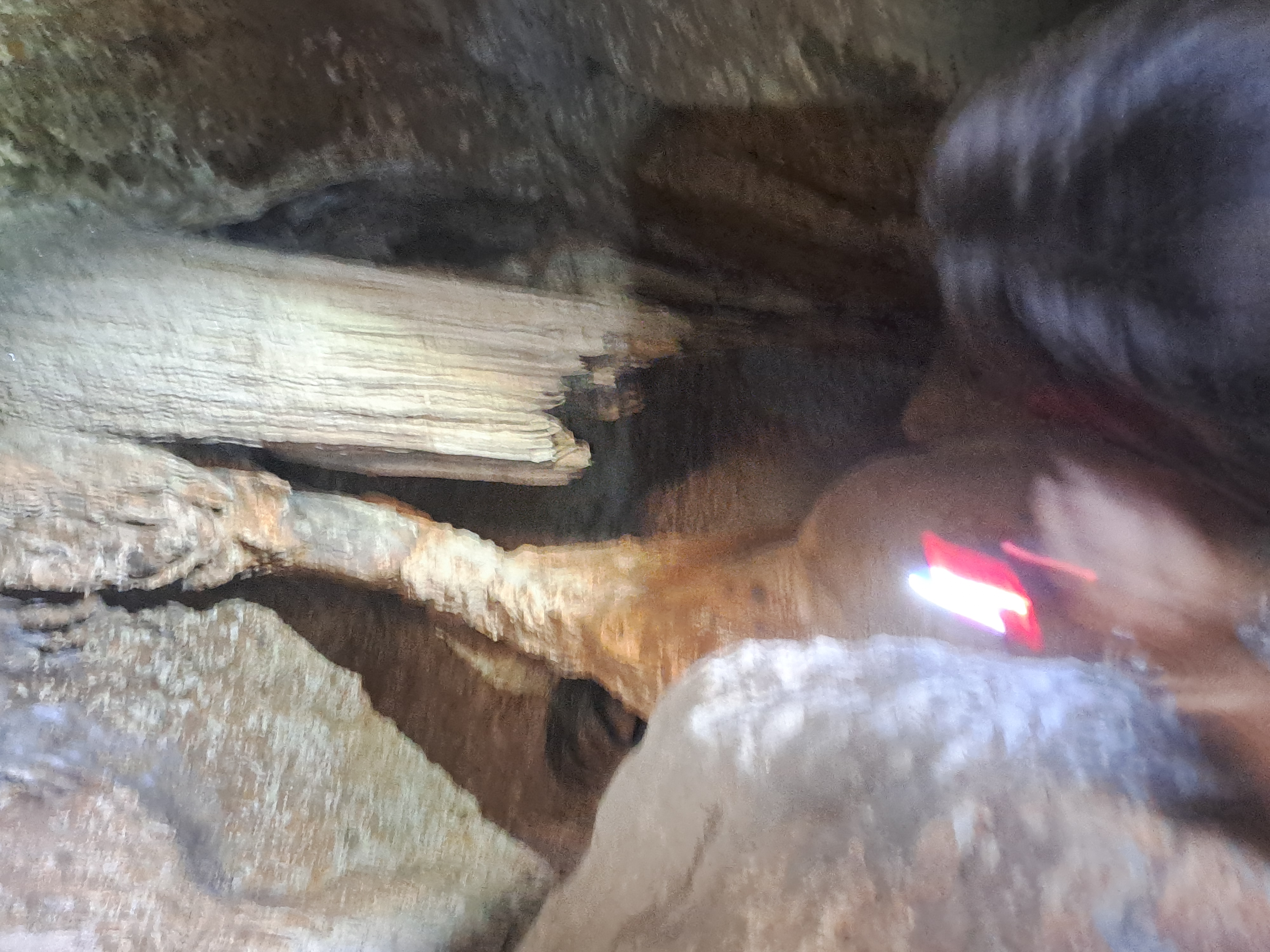
We were shown cave etchings of spiritual creatures who lure children away, making sounds like child’s play to attract them.
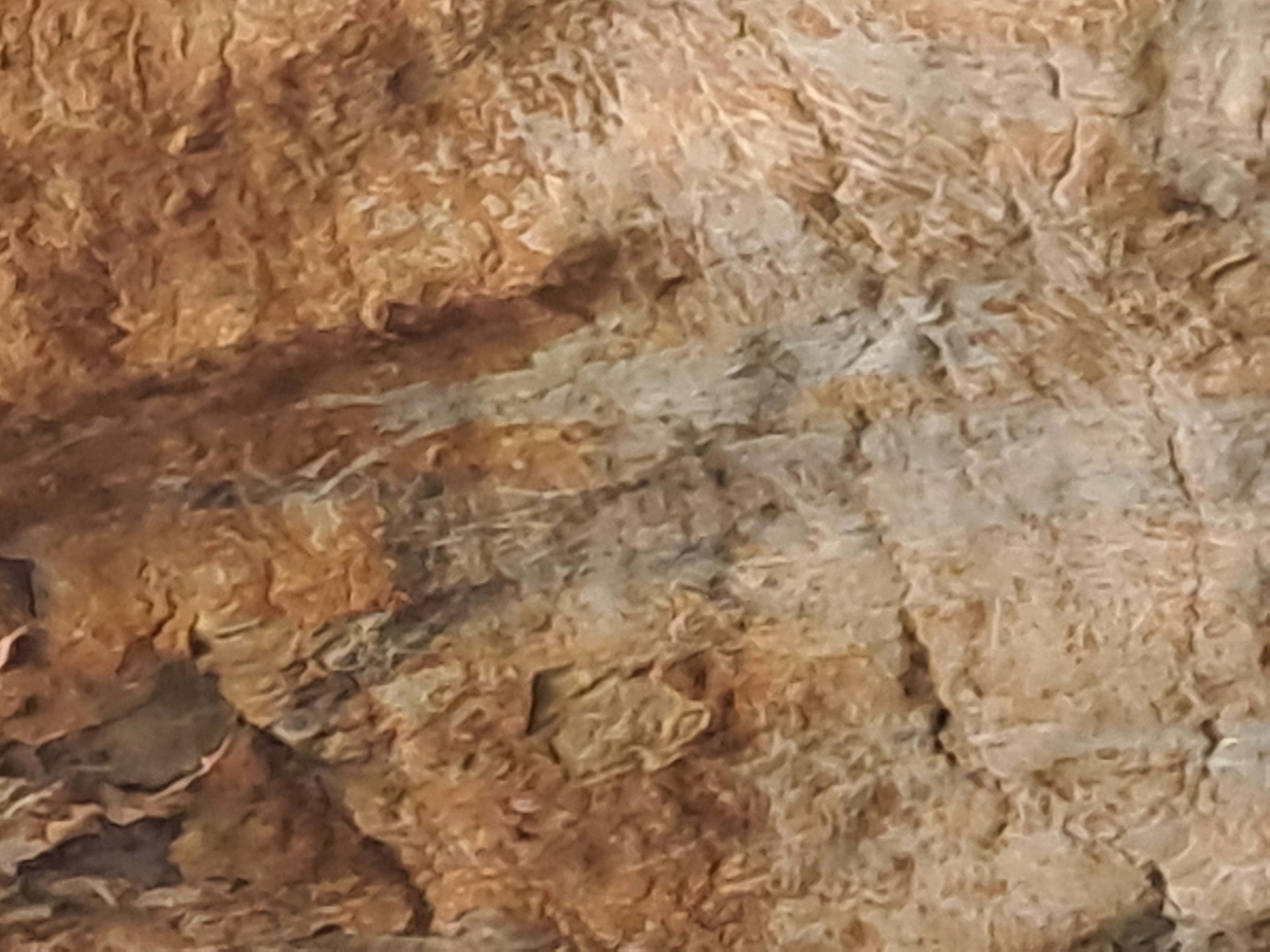

We then headed back to Fitzroy Crossing for a night. This time at another camp site, which is still recovering from the flooding in 2023. Here is the river looking very quiet at this stage of the year.
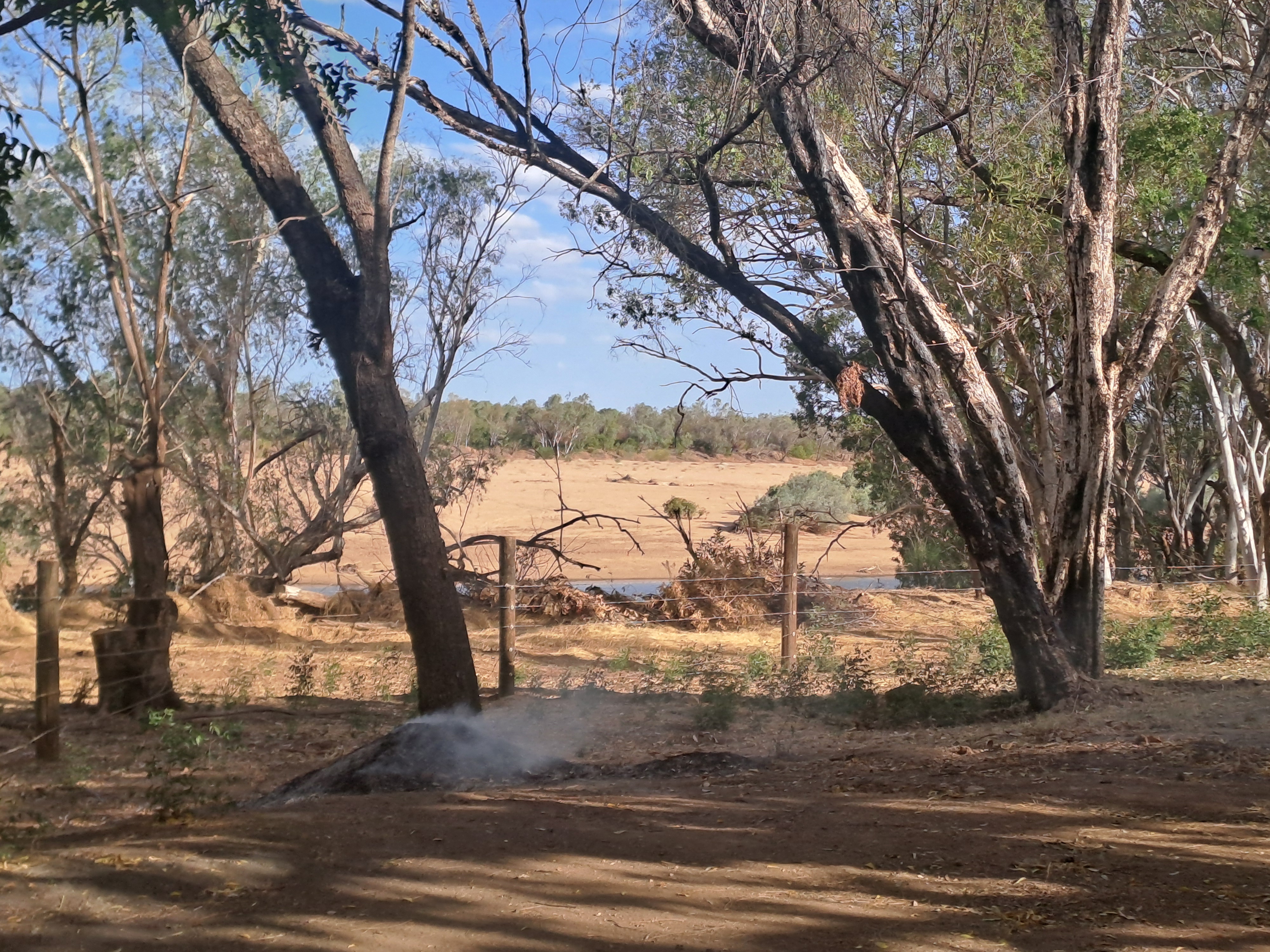
We took a detour to Derby on the way to Broome and stopped to see it’s most famous sight. The Prison Boab tree. This is estimated to be 1,500 years old and is culturally significant to the local people as a resting place. Cattle drovers used this as an overnight stop before Derby although it is called the prison boab tree there it is no evidence it was used to hold prisoners as some other hollow boabs were.
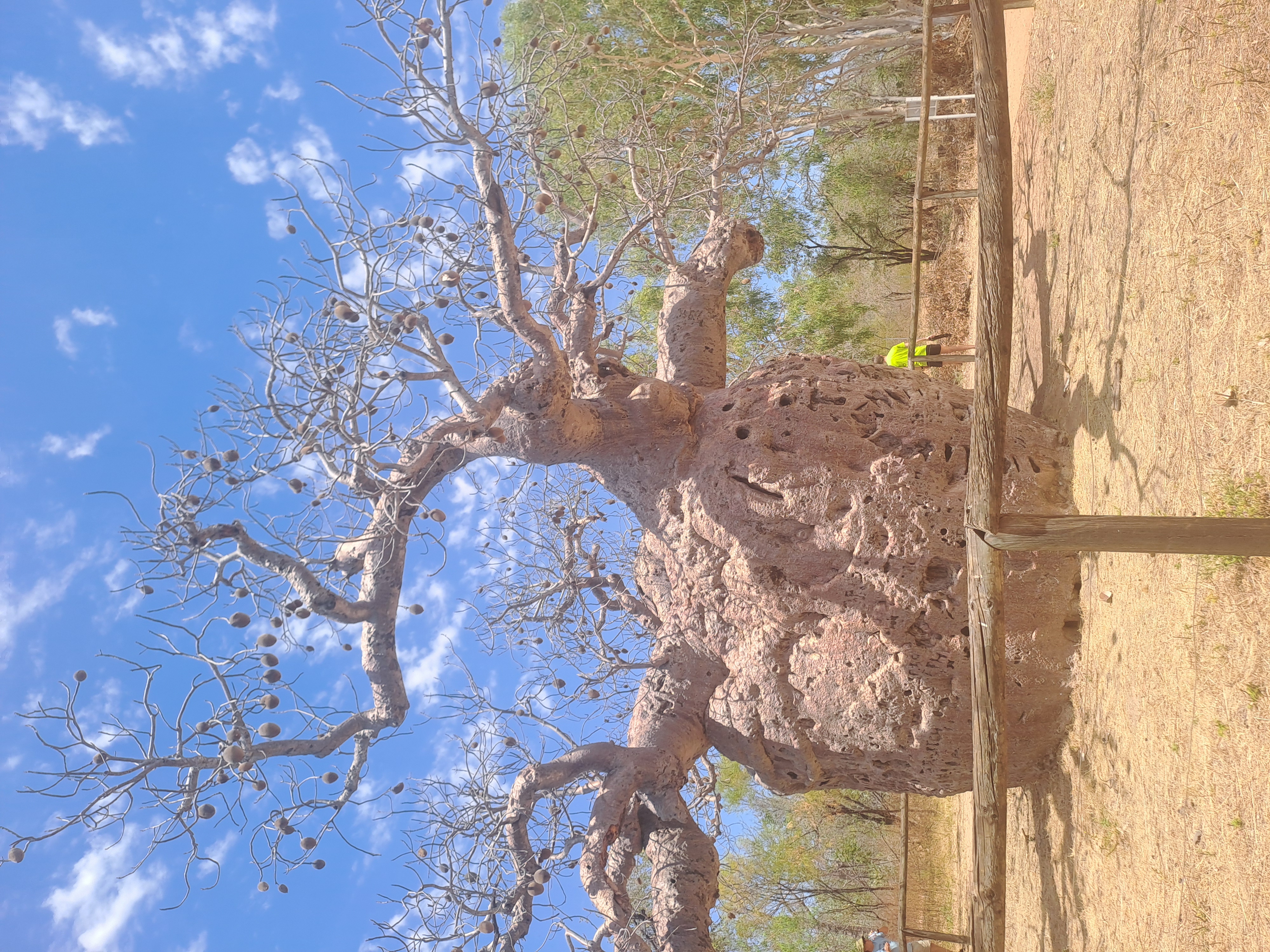
Boab trees are a real feature here, all down the side of the road and all around the town.
We went out to see the jetty, a journey along a narrow road over the Saltmarsh. Apparently the tide is really exciting here. It is the next highest range after Weston-super-Mare! You can guess how exciting that is, however, it promoted as a tourist attraction.
This was our first sea after Cairns, but it was a muddy brown and warnings about getting caught by the tide or crocodiles didn’t do a lot to encourage us. The jetty is so far out because like Weston-super-Mare there is no deep sea water near land so boats can’t get any closer.
Besides the Prison Tree and the tide, the other two items of interest are a town history trail and sculpture trail, so I did both the next morning.
I gathered that Derby had rather enthusiasticly been sold as prime pastoral land, probably a bit of a shock for those who came. The jetty had been built as this was the best they could do for a port. Further north across Australia the coast is all mangroves and pretty much inaccessible.
This used to be the nain port for cattle. Before the road was built across the Saltmarsh stock had to be forced to walk across. Hard work at the end of a long cattle drive of maybe 200km.
In the 1960s road trains came along. Although more expensive, money was saved in attrition of stock and the labour to get the stock to the port.
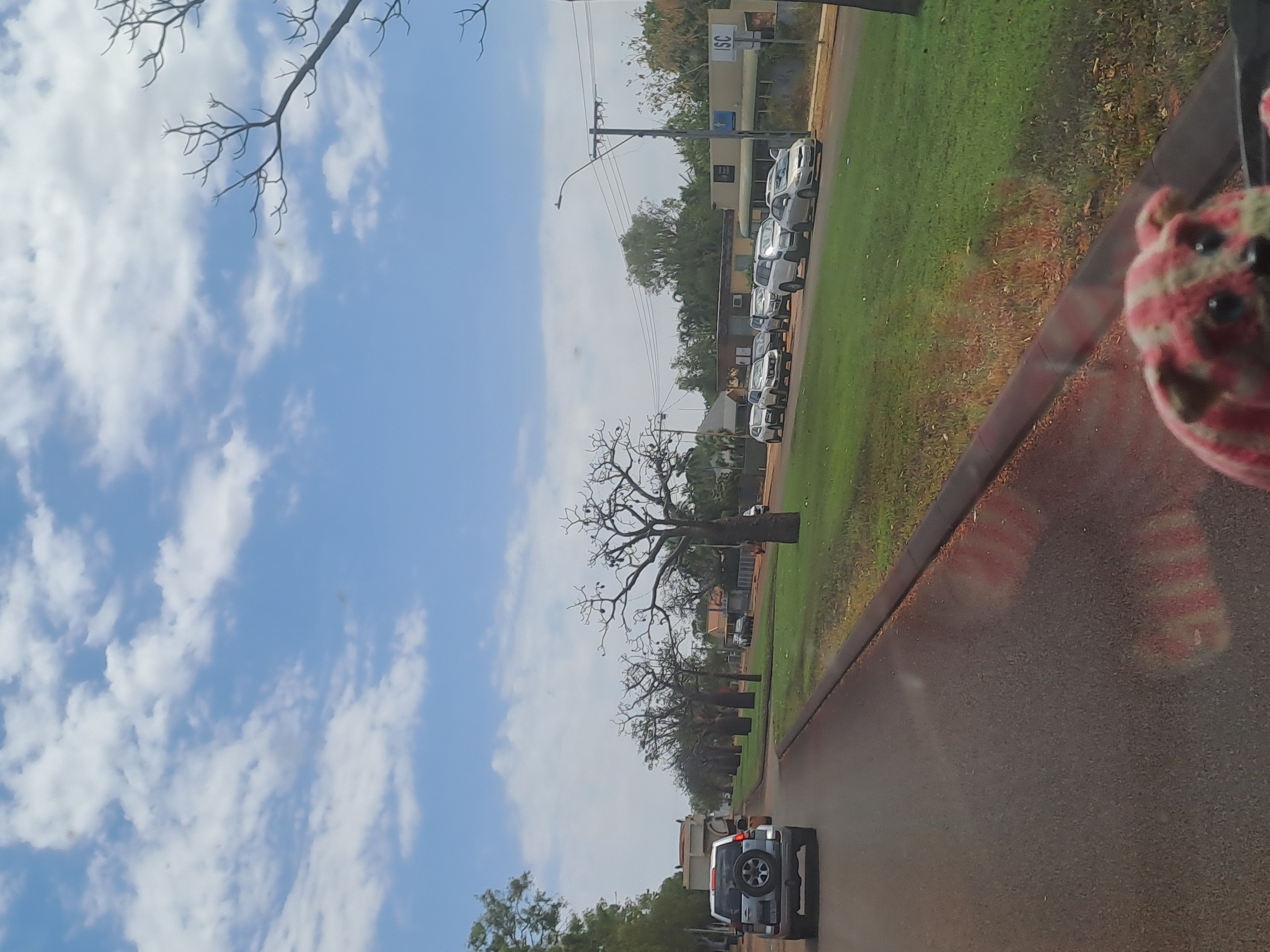

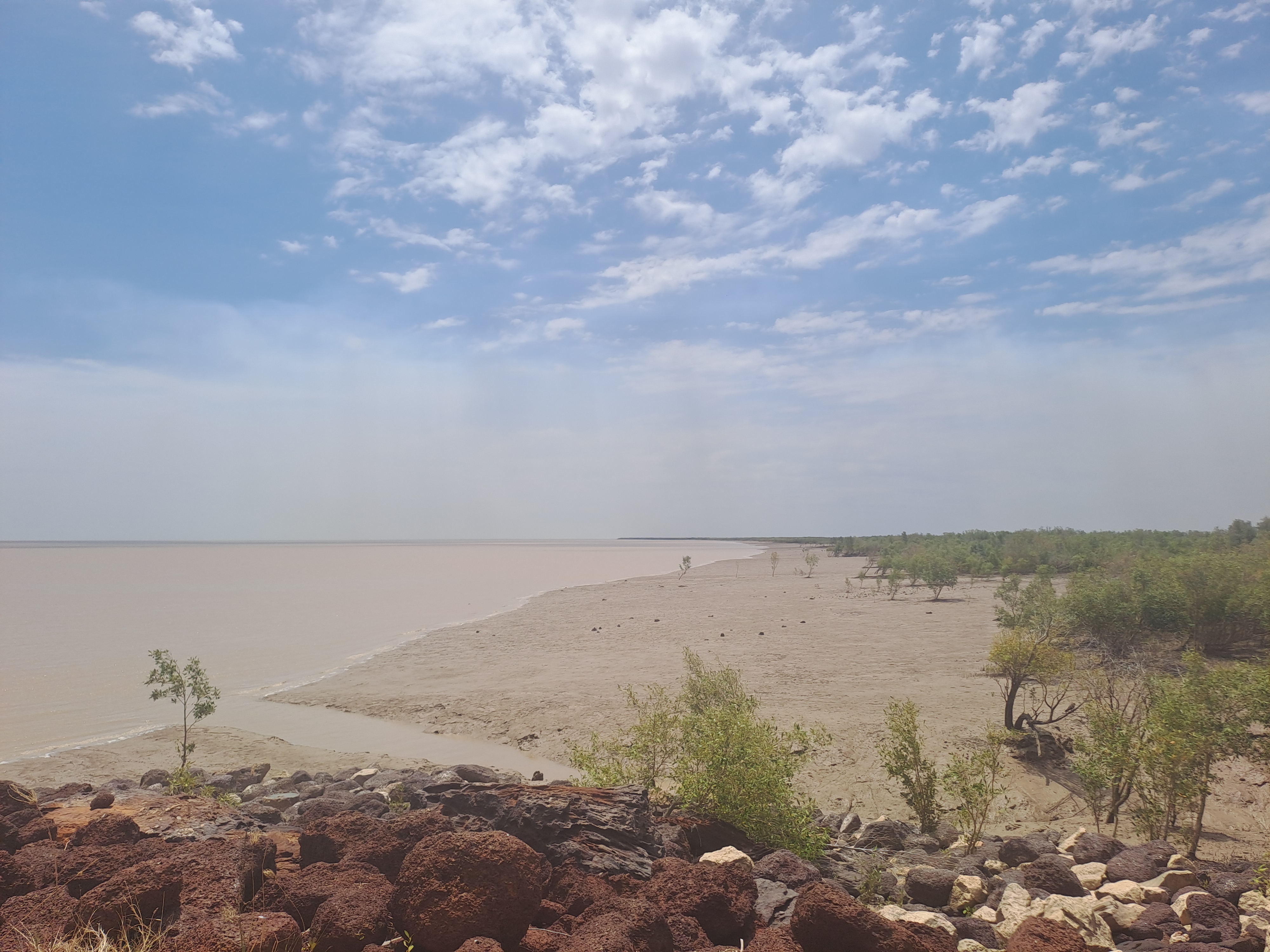

The sculptures were along the edge of the Saltmarsh, and depicted things important locally. I particularly liked the Brolga birds dancing to remind me of my dance with one.
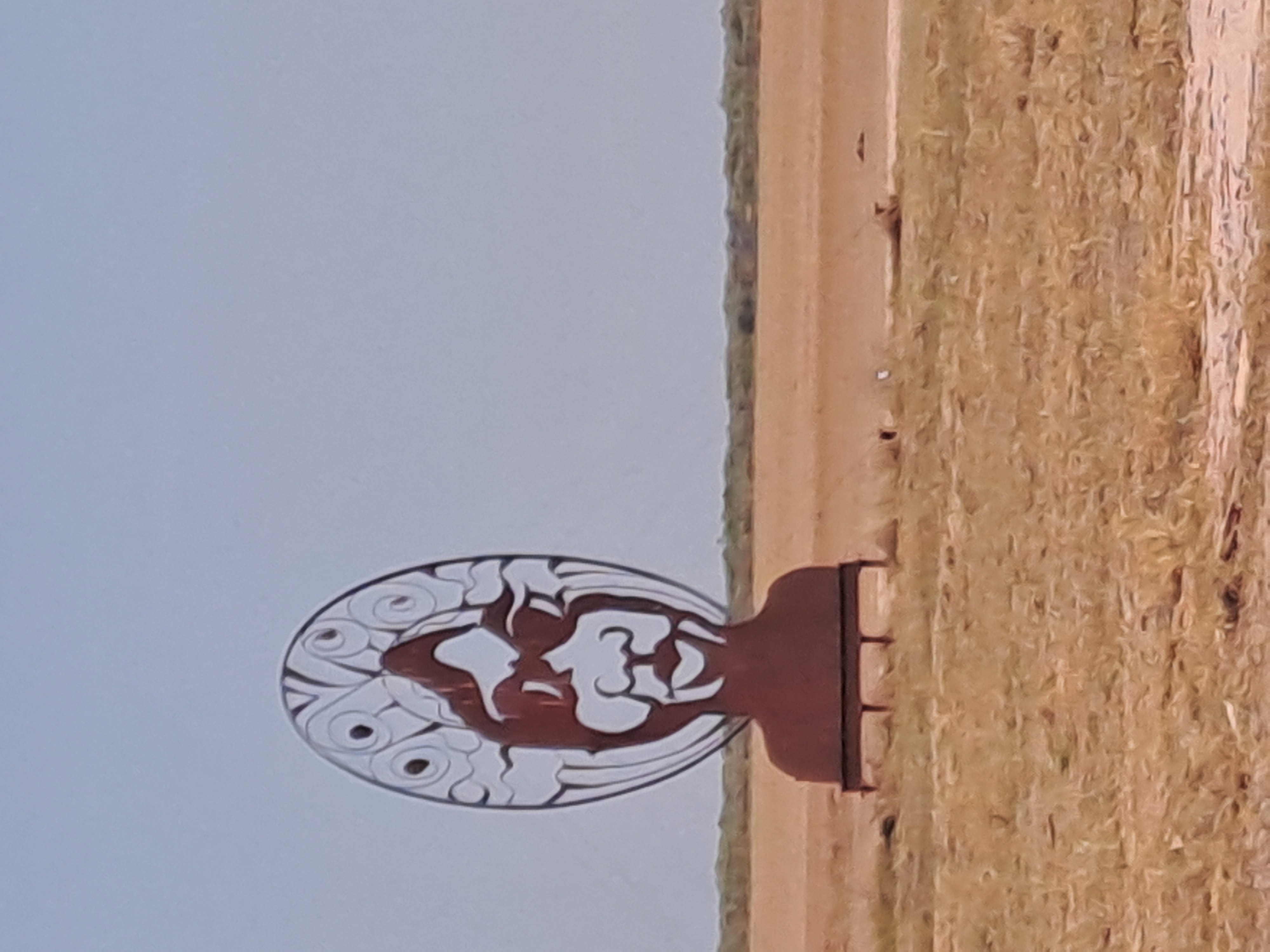

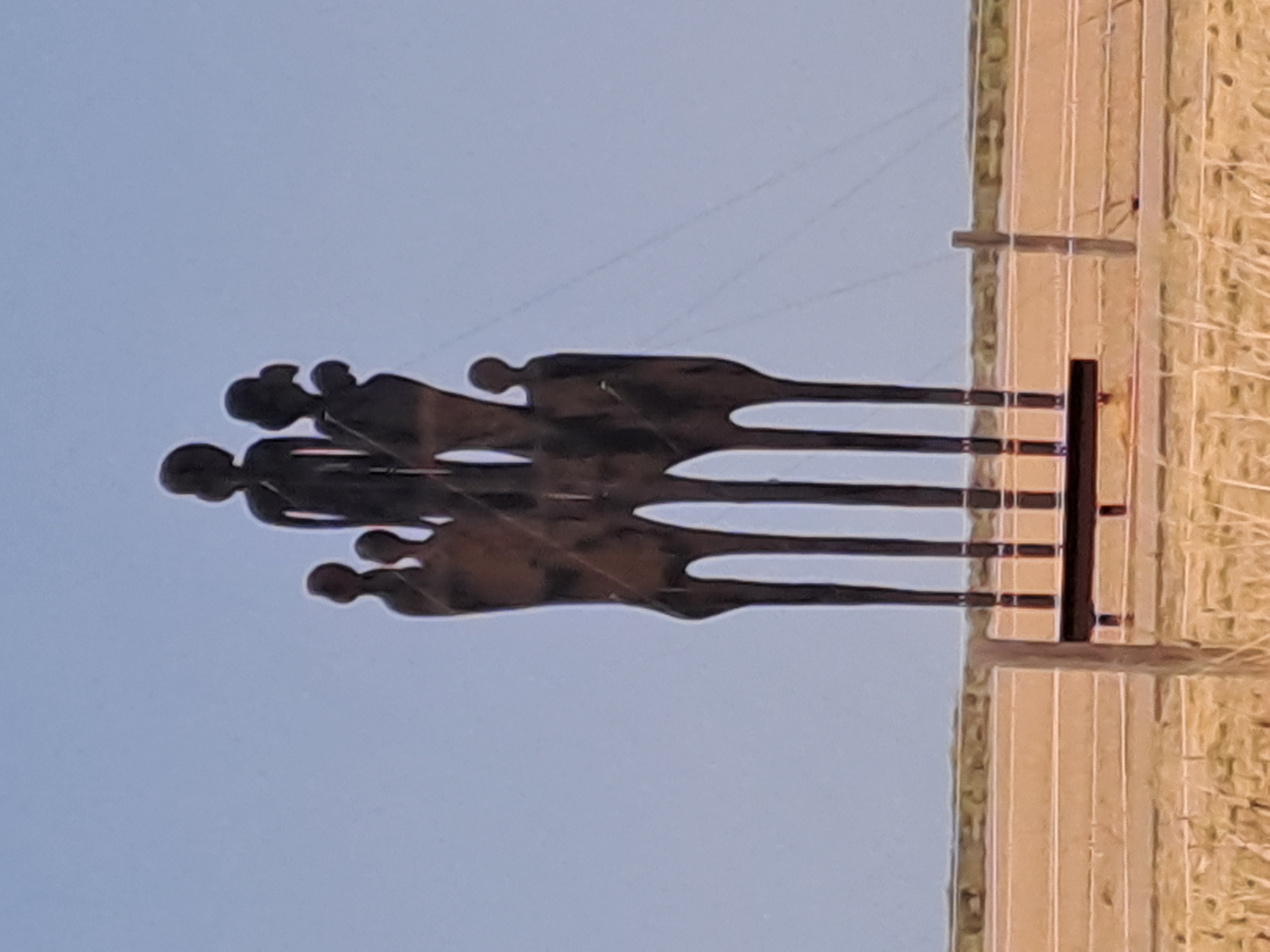
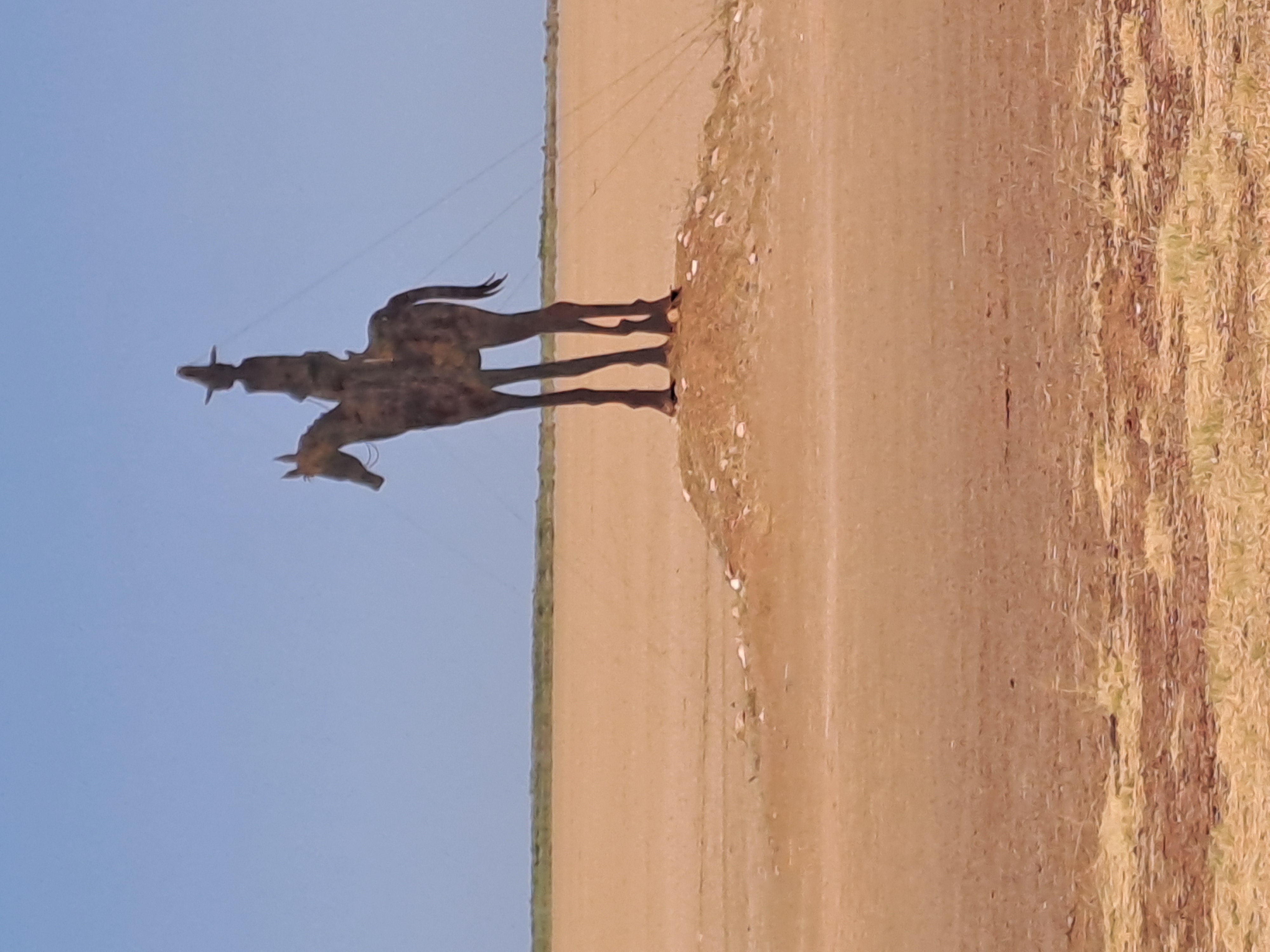
My last sight on the way back was a hollow Boab tree. Still growing leaves and a trunk feeling as hard as iron.
On a different note the birds here are definitely not shy and we’ve had to defend our lunch from the two below.
On the way to Broome we found that the road crosses many kilometers of wide rivers, one after the other. Interestingly although most of the dry beds were marked on the map, some of the very wide water filled rivers weren’t. This is where a whole heap of rivers all come out to the coast together. A big sign warns if flooding between November and April and and 10km of flood way! After that another 10k of flood way. That’s why the kangaroos can’t do the journey from Kununurra to Broome in the wet season!

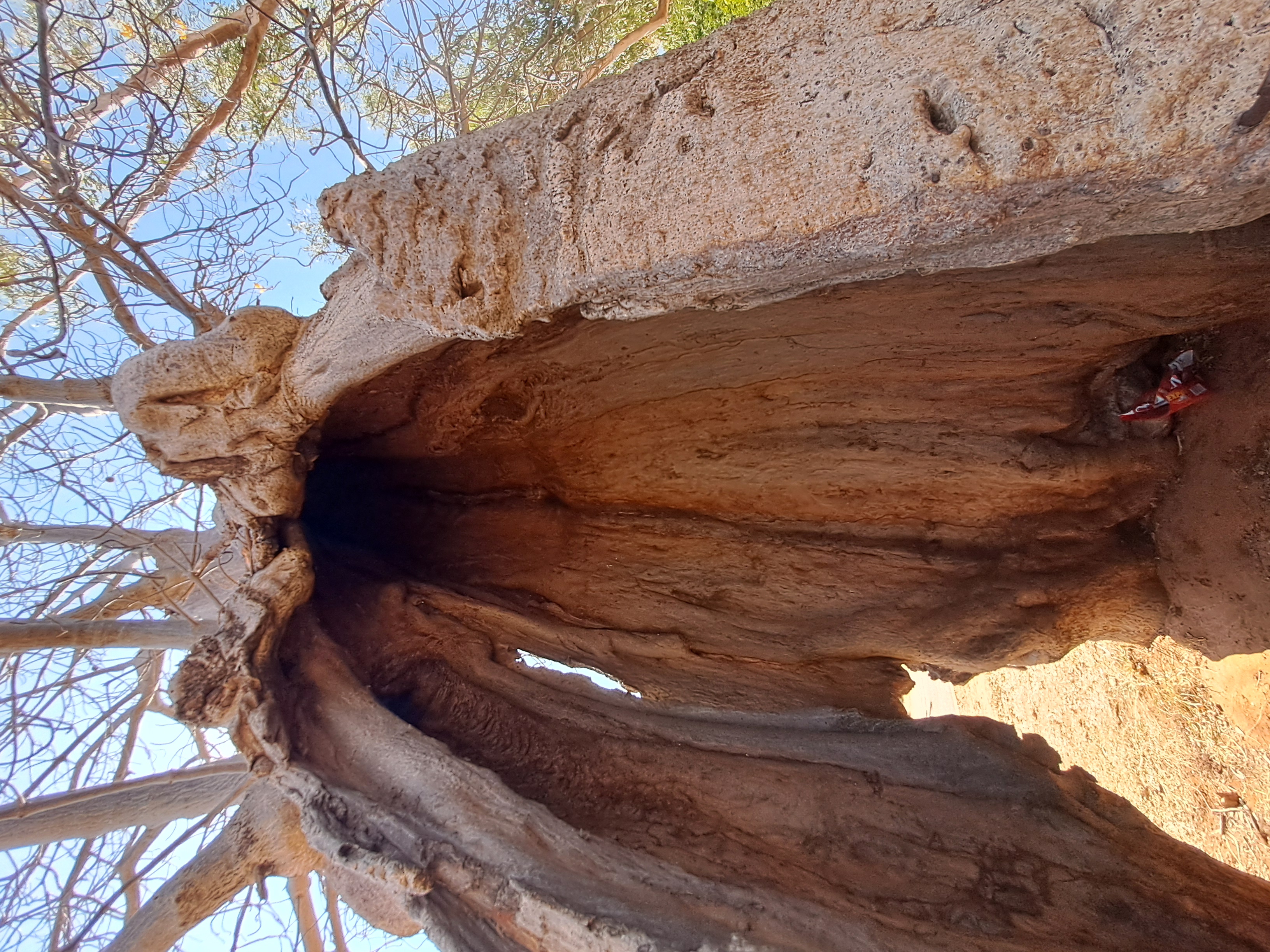
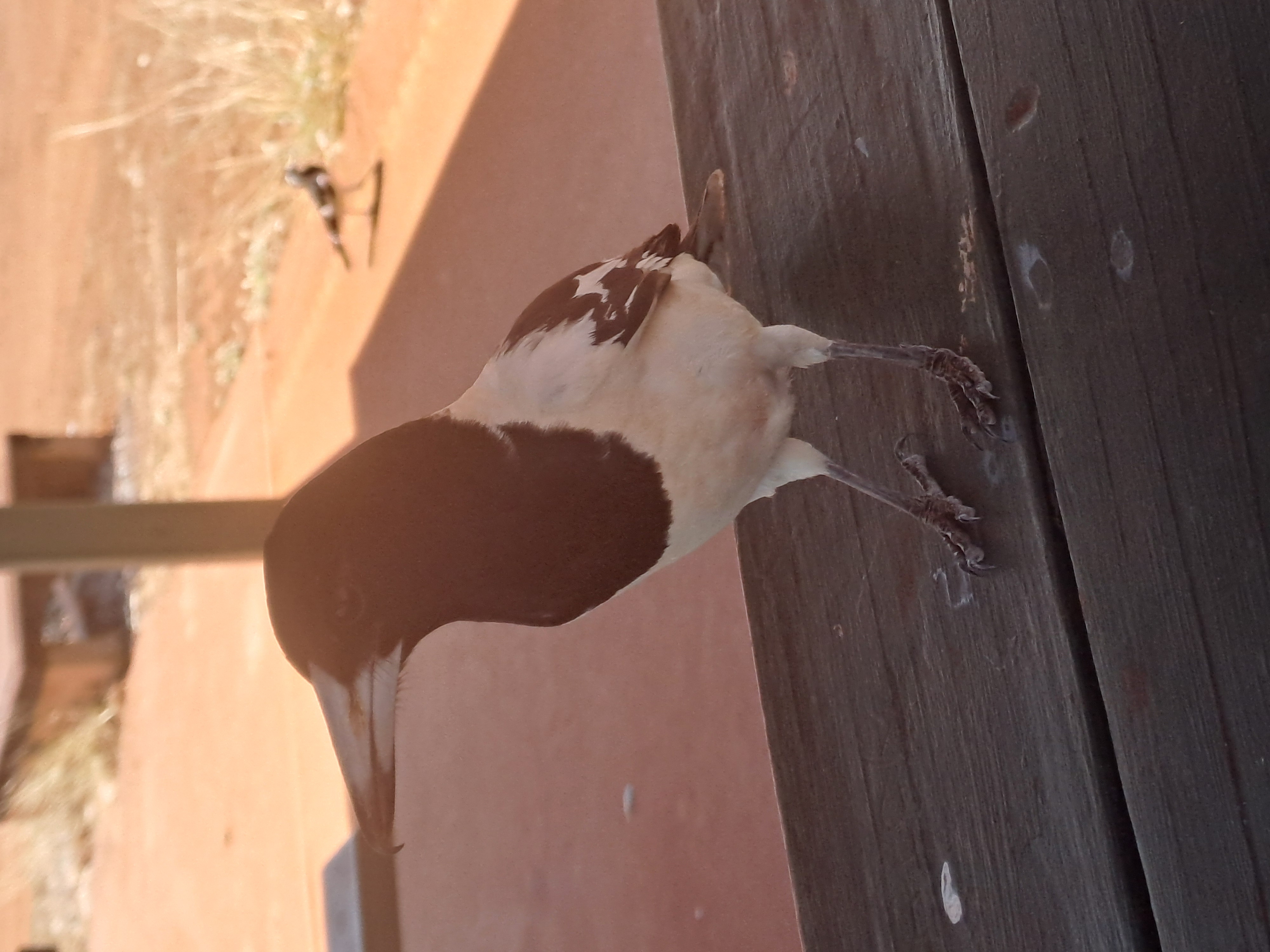
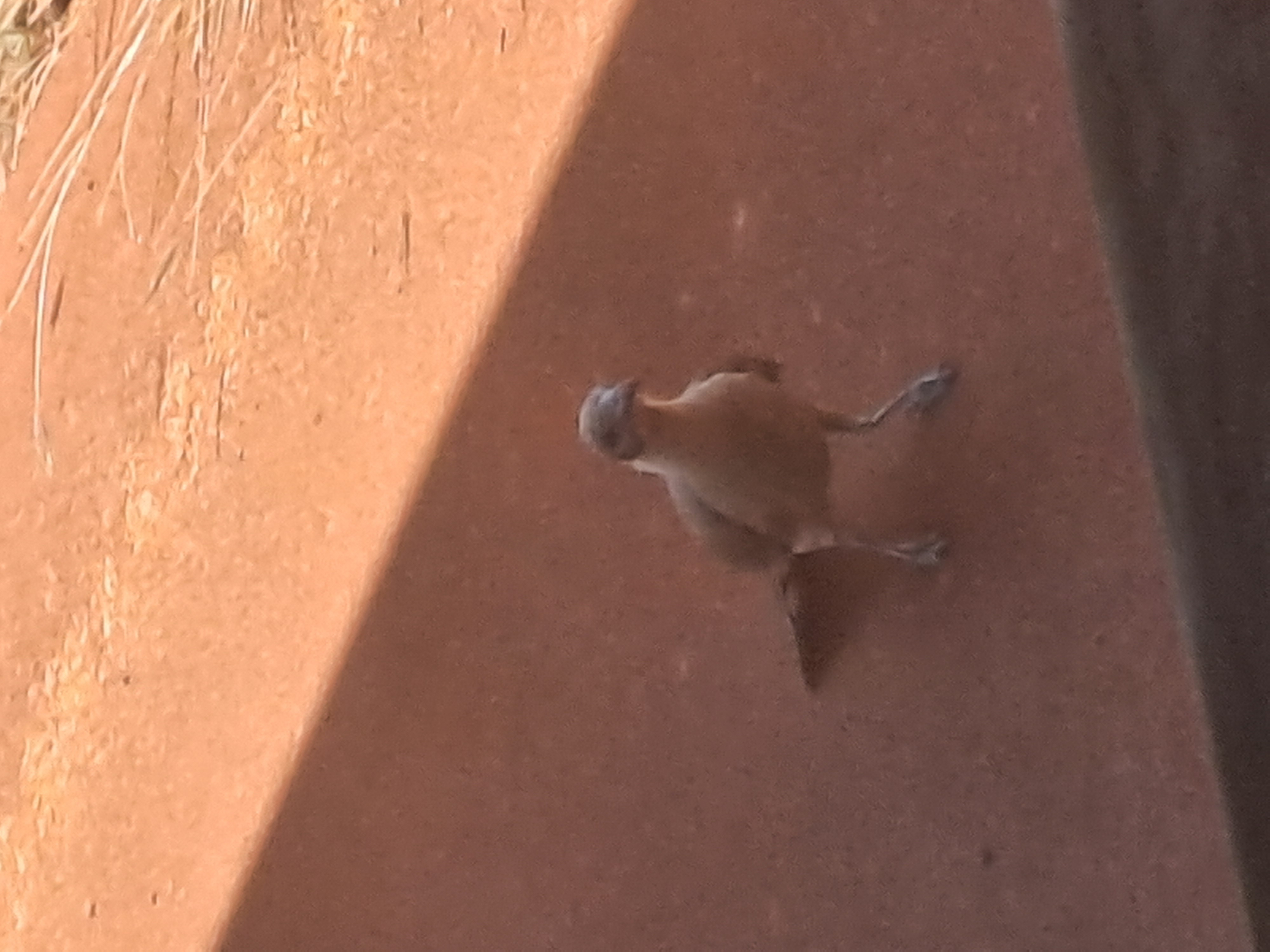
Broome was our final stop along the top of Australia, and an opportunity to see some beautiful turquoise sea, even if there were notices everywhere warning of the dangers of crocodiles.
We went to the local museum to find out more about the reason for the existence of Broome, pearl diving.
Broome became the capital of the pearl diving industry from the 1880s. A variety of other nationalities were involved and had been for many years, such as Indonesians and Filipinos and Japanese. Aboriginals also had the skills and were good at pearl diving. However as the shallower waters were depleted the more dangerous deeper water were farmed and Aboriginal people were forced to dive or even kidnapped (blackbirding) to dive for shells as it became more dangerous as they weren’t given any equipment and had deeper dives. In effect they were slaves st a time when slavery had been abolished in the British Empire.



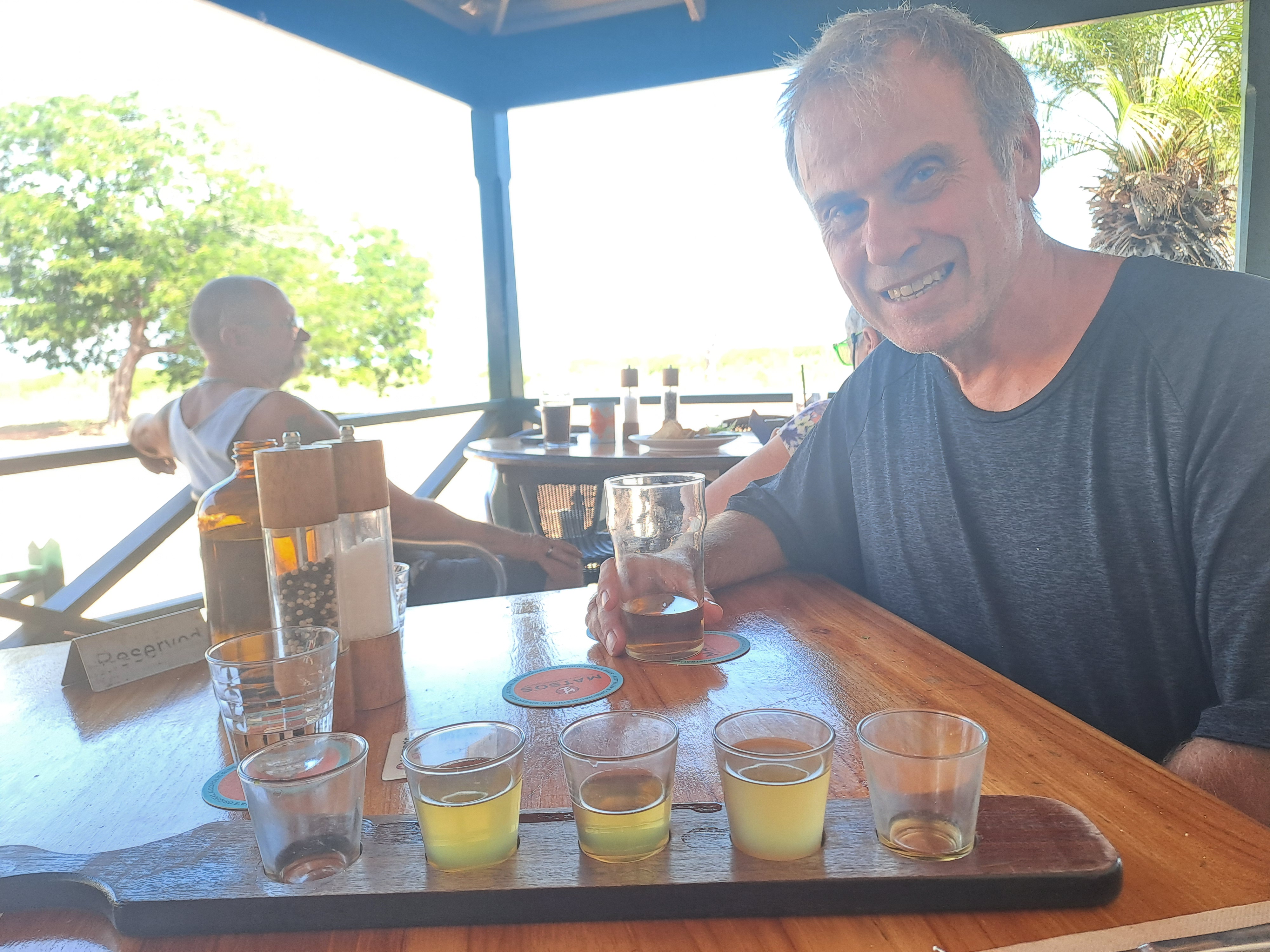
After this and a quick bottle shop visit we headed for the local Matso brewery for a sample of their brews. Such as alcoholic ginger beer, mango flavour, chilli flavour and combinations Ashley stuck to the more traditional lager flavours.
To finish off we went to the wilderness centre to see close up crocodiles. Our last opportunity before we head down south.
This is the home for those crocs not able to live in the wild or the bad boys, plus those bred in captivity. Apparently moving nuisance salt water crocodiles doesn’t work. They will travel hundreds of miles to get back home. So they get moved to their own luxury suites here.
We got taken round for feeding time and a lesson in how fast these creatures can move, suddenly rearing up from nowhere out of the water several feet to grab some meat.
Some if the crocodiles here had been shot. Where they had lost an eye they came here. Anywhere else it needs a very powerful gun to get through their skull.



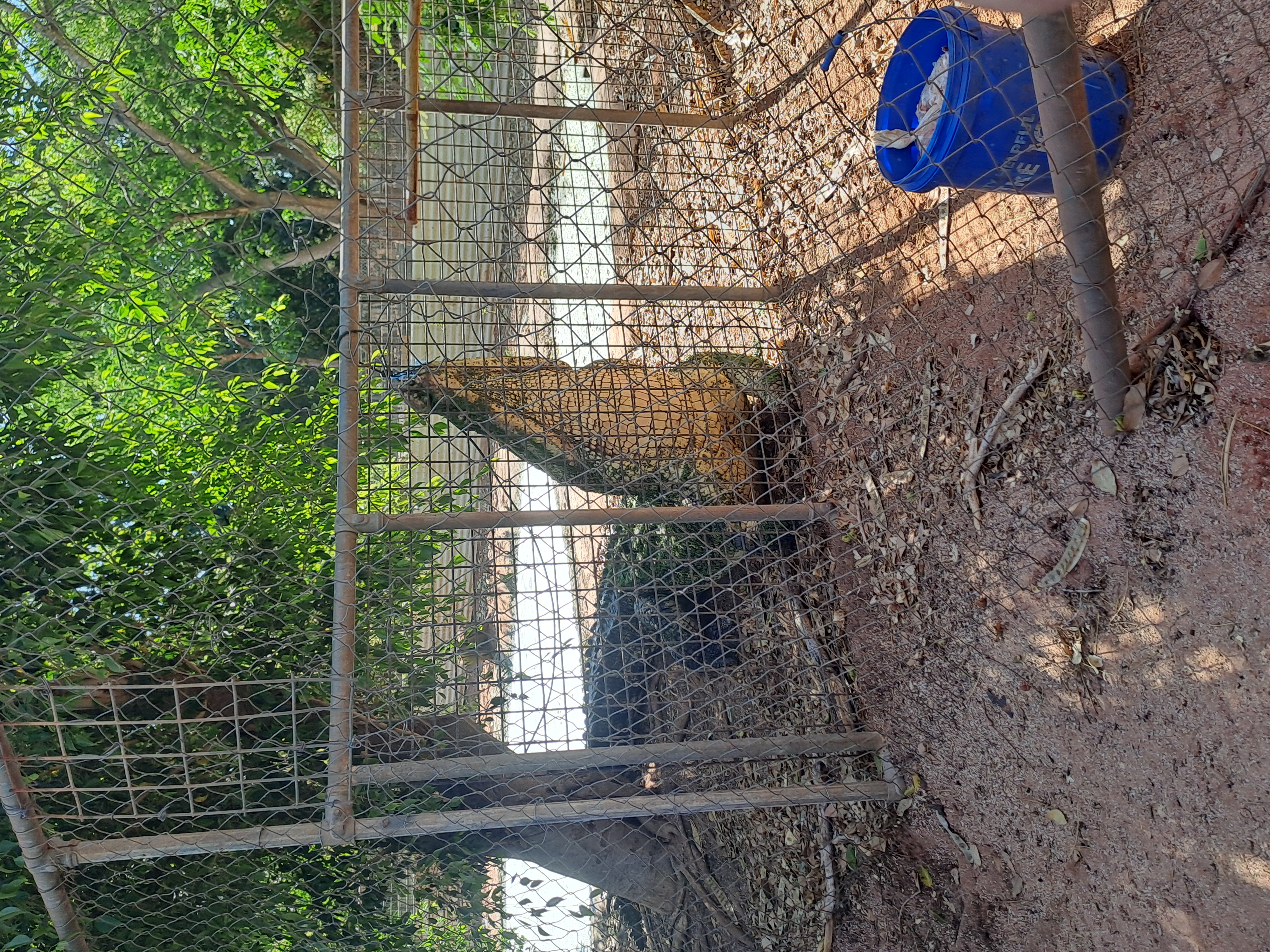
The majority of the crocodiles live in one big lake. Although in the wild a male will have his own territory and see off any other males, here they have adapted to sharing with just the occasional jockeying for power, as evidenced by one bloody snout.
I also got the chance to handle a small saltie. I could just about cope with this one, who will be my last crocodile in Australia.
